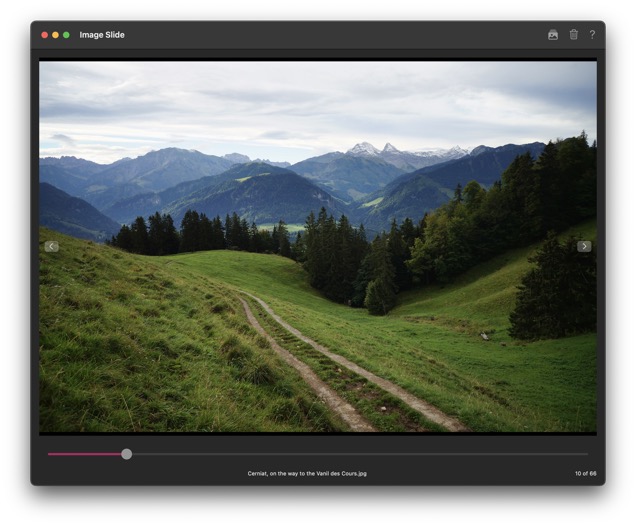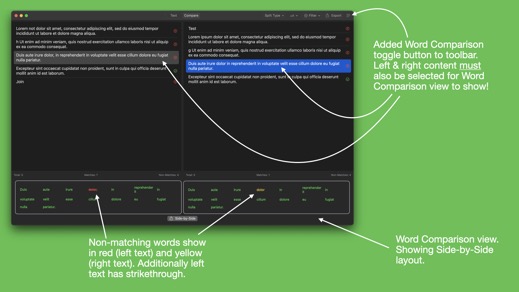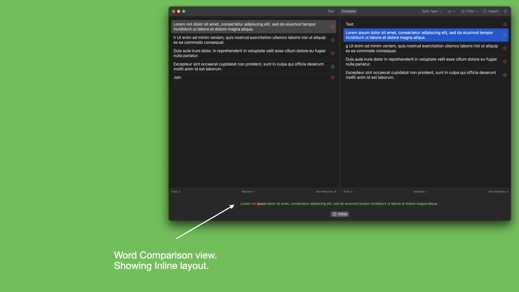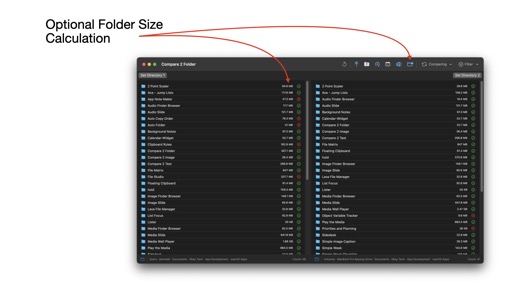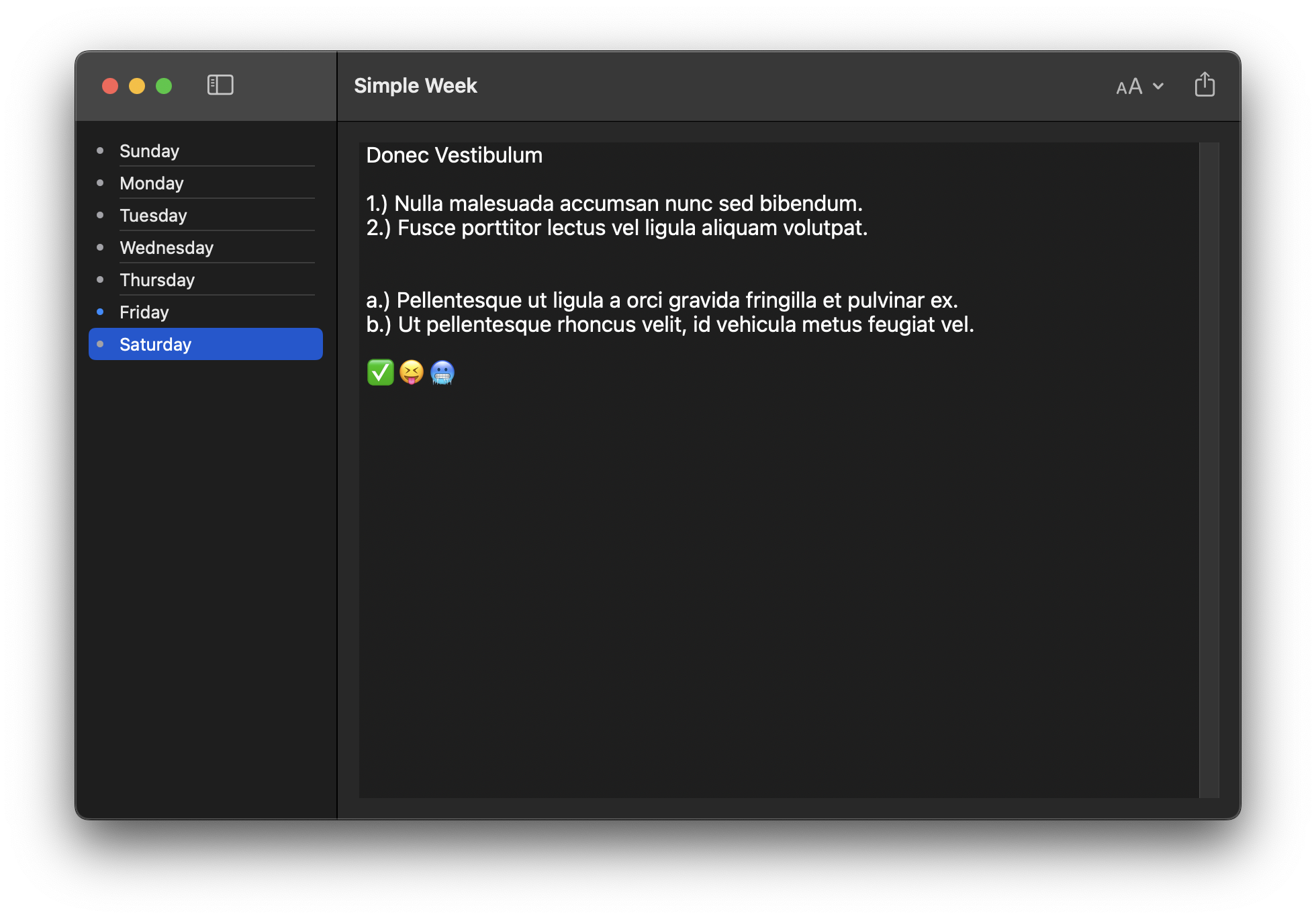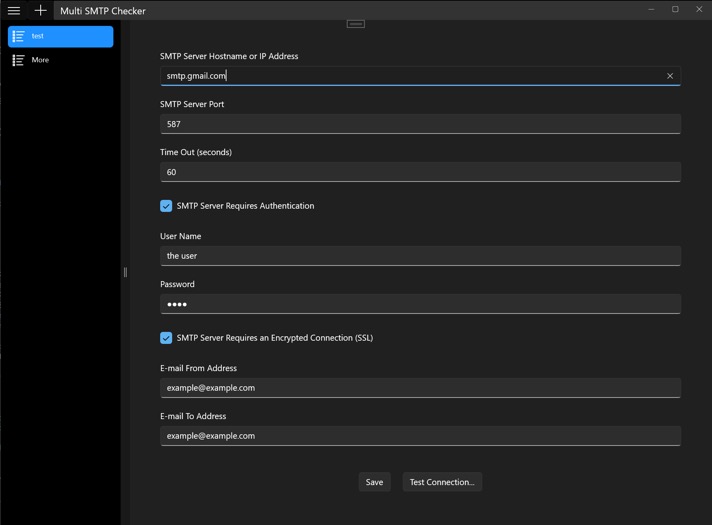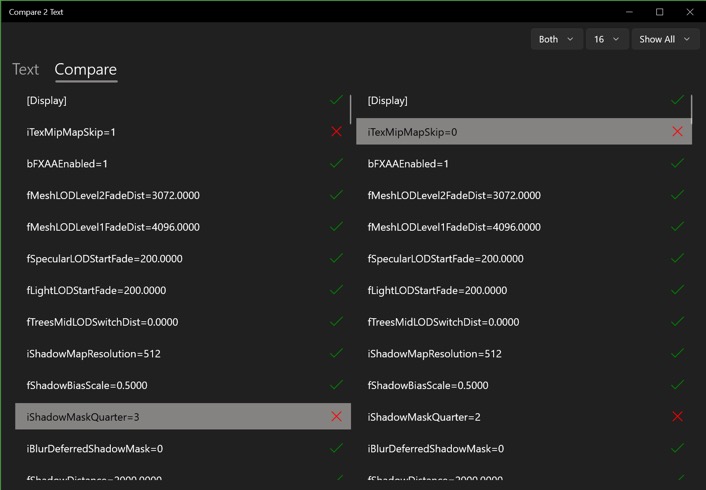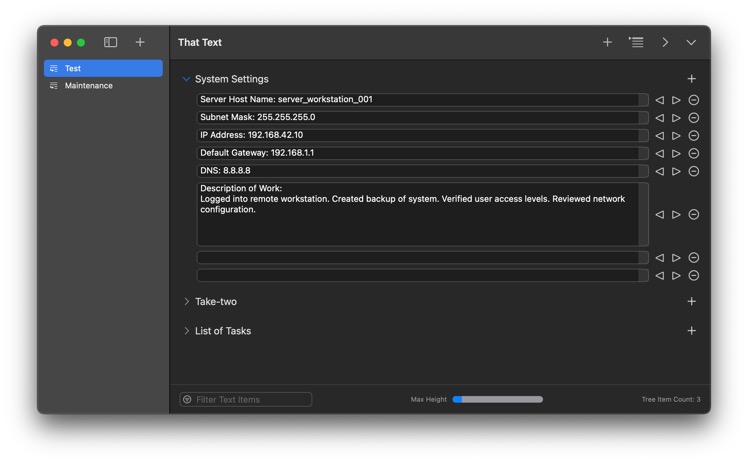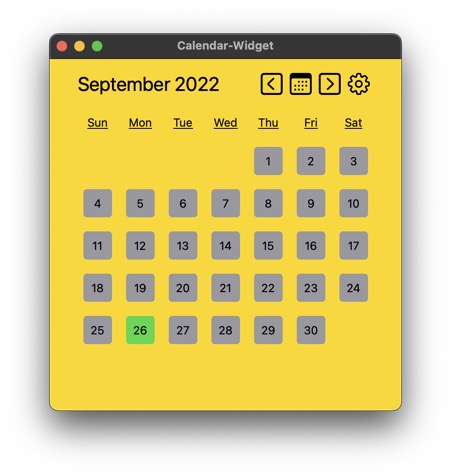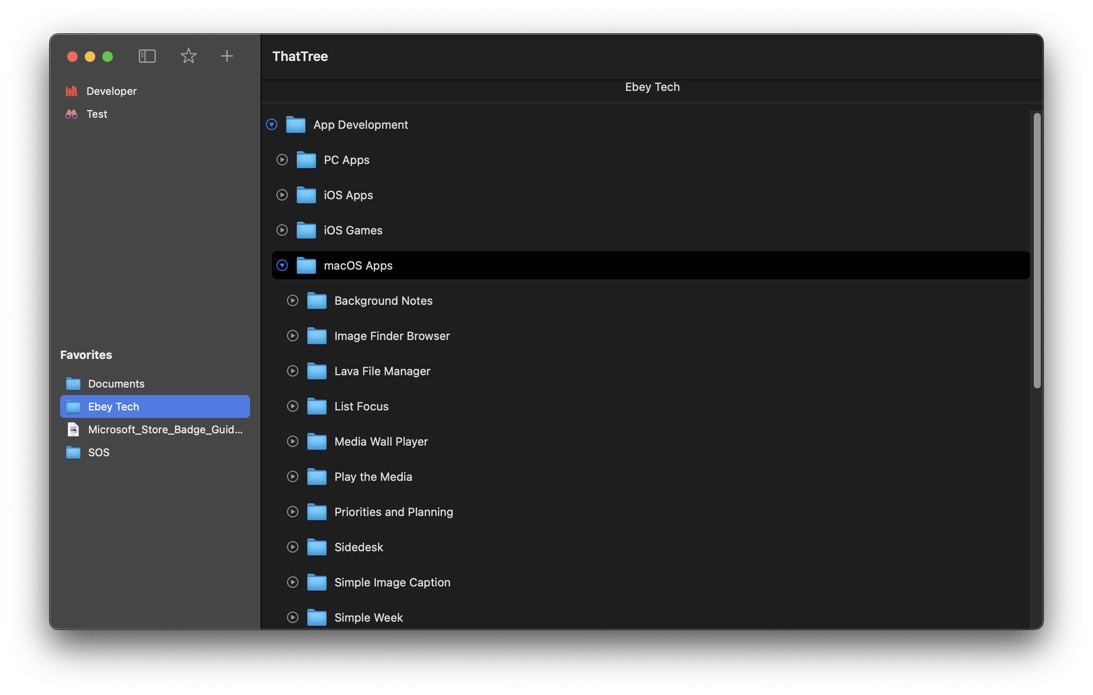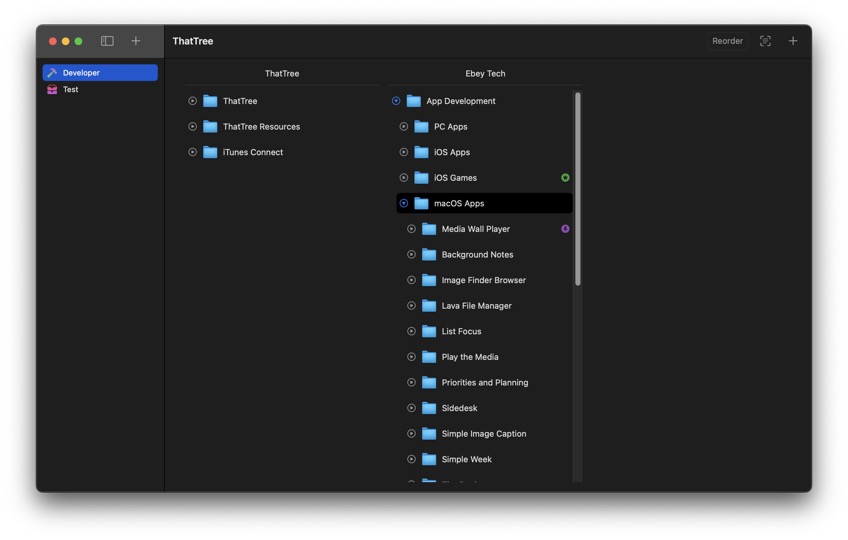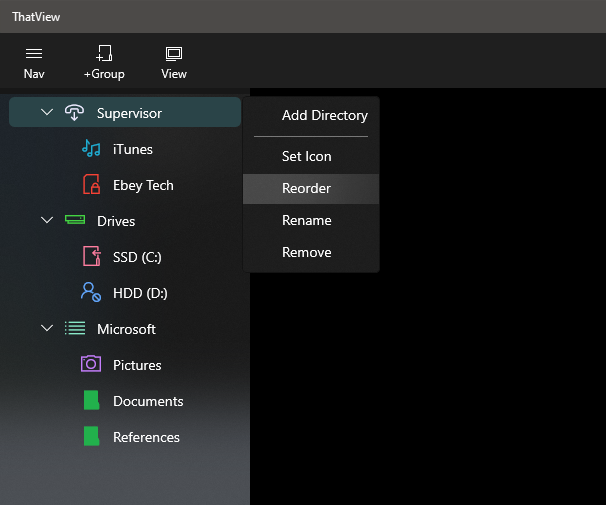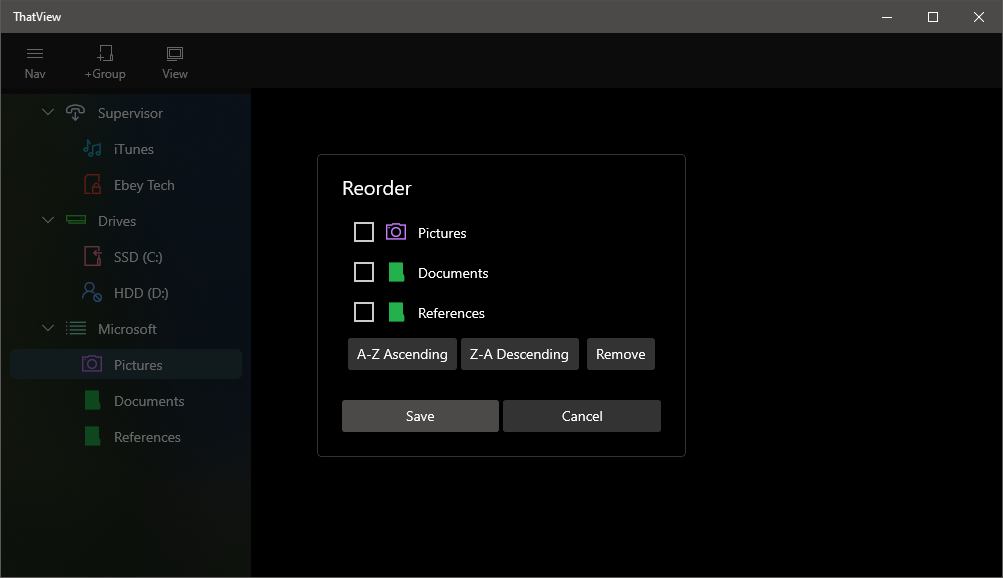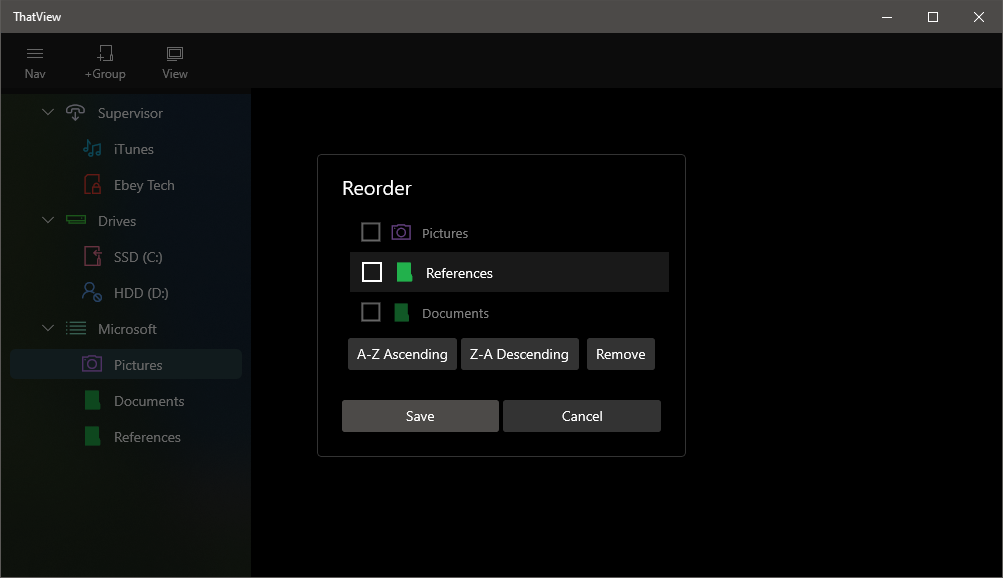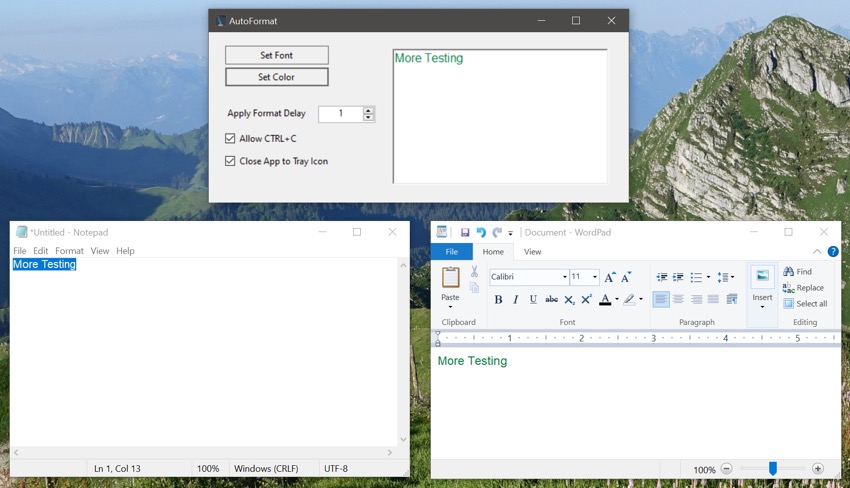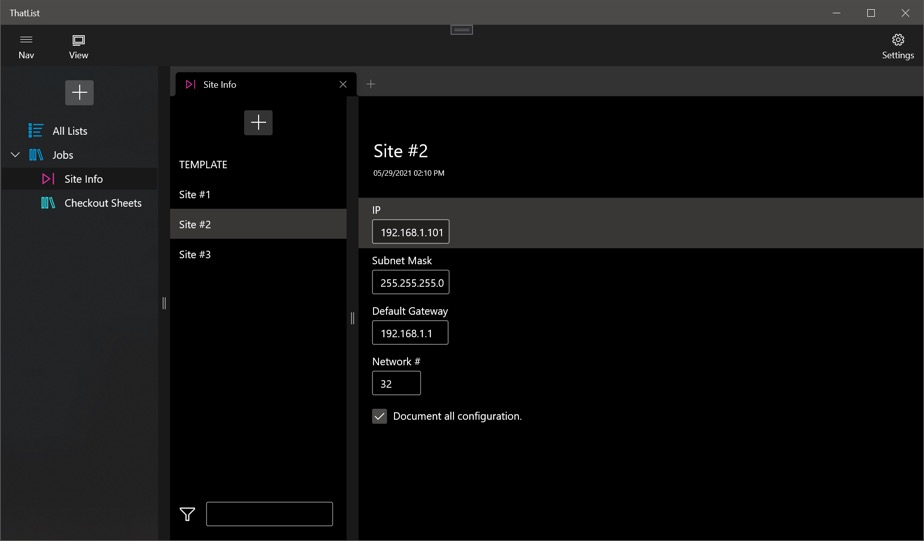Apps
Move File There for macOS v1.0 Release
03/14/2025 Filed in: Move File There

Move File There for macOS is now available!
Move File There is the best way to move files for macOS. It has been developed to provide a consistent and fast experience, especially when moving files in large directories. Dedicated source directories allow resuming from previous file move sessions. A dynamic file view provides a list, grid, or gallery layout to see files. Customizable folder destinations give unique control to users, so you can move files with ease. After moving a file the app automatically selects the next file, so at times you may only need to click one button (Move button).
Instructions for app operation:
1.) Startup app.
2.) In the upper left corner of the app window, click the + button. Navigate to a desired folder containing files. With the folder selected, click "Open".
3.) The added folder will appear in the left-side navigation list. Repeat process for adding new folders. Folders containing files can also be dragged/dropped onto the left-side navigation area to be added.
4.) Click the newly added folder. The "Files to Move" section will populate and list out any files contained in the chosen folder.
5.) Click the + button in the upper right corner of the app's window, toolbar area. Navigate to the desired folder, where you would like to "move" file(s) to. These folders are known as "Move Locations". You can also drag and drop folders into the Move Locations area.
6.) To complete a "move" operation, select a file from the middle "Files to Move" area, then click the "Move" button for the desired "Move Locations" folder. This will complete a macOS "move" operation, moving the file from the source folder to the destination folder.
7.) Upon move completion, if user needs to "return" the file back to the source, 3 dots will appear next to the Move Location's folder. Under the 3 dots, will list out all files moved to that location. Clicking the listed file there will return the file back to the source. This list will not "persist" through other source directory navigations nor app restarts.
8.) To see all "Move Locations" added within the app, even locations added under different Source Directories, use the 3 dots next to the "Move Locations" top title, called "Show All Locations".
9.) Added folders under the "Move Locations" area each have right-click options, one option called "Pin" will allow the folder to stay "pinned" to the top of the list, even if alternate sort methods are changed.
Recent Apps for Windows v1.0 Release
02/01/2025 Filed in: Recent Apps
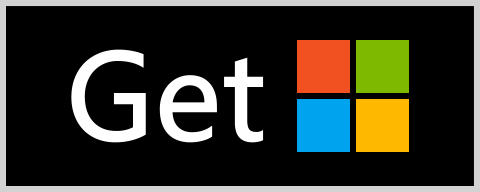
Recent Apps for Windows is now available!
Recent Apps lists out current and previously launched applications. Choose from viewing content in a detailed list-view or a visually stunning grid-view. Use built-in toggle buttons to hide/show additional app details, like app path, launch date and launch count. Re-launch previous apps by double-clicking them. Easy pin and favorite functions allow easier and faster recent app management. Use the hide command to hide unneeded apps from view. Use the “Show Hidden” toolbar button to see previously hidden apps. Toolbar placed filter buttons give quick and easy access to common filtering needs, like favorite or to filter apps by just today’s launch date. The toolbar also has an easy to use Search field, which will dynamically populate below content with search results. Recent Apps must be running to track app use. It works independently from operating system’s tracking of recent apps.
Features:
* List of recent apps.
* App management.
* Track app use.
* List-view and grid-view layouts.
* Toggle properties for path, launch date, and launch count.
* Launch apps by double-clicking.
* Pin apps to top.
* Favorite apps.
* Hide apps from list.
* Filter by favorite, running, and today’s launch date.
* Search apps list.
Instructions for app operation:
1. Launch Recent Apps.
2. Launch other desired apps.
3. Recent Apps will build a historical list of launched apps.
4. Apps that are quit will remain in the list and appear dimmed.
5. Running apps will not appear dimmed.
6. Choose view layout, list-view or grid-view.
7. Choose optional properties to view - path, launch date, and launch count.
8. Re-launch an app by double-clicking. Double-clicking an already running app will make it active or may launch a new window.
9. Right-click an app and choose Pin to keep the app at the top of the list/grid (regardless of filter).
10. Right-click an app and choose Favorite to place a vibrant star next to app. Favorited apps will be shown when filtering by Favorite.
11. Right-click an app and choose Hide/Show to toggle between hiding and showing the app.
12. The toolbar has a toggle for showing hidden apps.
13. When an app is hidden, if it was pinned or favorited, those properties are removed - to avoid filtering confusion.
Compare 2 Text for macOS v1.6 Updates
01/25/2025 Filed in: Compare 2 Text
Image Slide for macOS v1.3 Updates
12/31/2024 Filed in: Image Slide
Compare 2 Text for macOS v1.5 Updates
12/28/2024 Filed in: Compare 2 Text
Recent Apps for macOS
11/27/2024 Filed in: Recent Apps

Recent Apps for macOS is now available!
Recent Apps lists out current and previously launched applications. Choose from viewing content in a detailed list-view or a visually stunning grid-view. Use built-in toggle buttons to hide/show additional app details, like app path, launch date and launch count. Re-launch previous apps by double-clicking them. Easy pin and favorite functions allow easier and faster recent app management. Use the hide command to hide unneeded apps from view. Use the Options menu “Show Hidden” command to see previously hidden apps. Toolbar placed filter buttons give quick and easy access to common filtering needs, like favorite or to filter apps by just today’s launch date. The toolbar also has an easy to use Search field, which will dynamically populate below content with search results. Recent Apps must be running to track app use. It works independently from operating system’s tracking of recent apps.
Features:
* List of recent apps.
* List-view and grid-view layouts.
* Toggle properties for path, launch date, and launch count.
* Launch apps by double-clicking.
* Pin apps to top.
* Favorite apps.
* Hide apps from list.
* Filter by favorite, running, and today’s launch date.
* Search field to find apps by name.
Instructions for app operation:
1. Launch Recent Apps.
2. Launch other desired apps.
3. Recent Apps will build a historical list of launched apps.
4. Apps that are quit will remain in the list and appear dimmed.
5. Running apps will not appear dimmed.
6. Choose view layout, list-view or grid-view.
7. Choose optional properties to view - path, launch date, and launch count.
8. Re-launch an app by double-clicking. Double-clicking an already running app will make it active.
9. Right-click an app and choose Pin to keep the app at the top of the list/grid (regardless of filter).
10. Right-click an app and choose Favorite to place a vibrant star next to app. Favorited apps will be shown when filtering by Favorite.
11. Right-click an app and choose Hide/Show to toggle between hiding and showing the app.
12. The Options menubar has a toggle for showing hidden apps.
13. When an app is hidden, if it was pinned or favorited, those properties are removed - to avoid filtering confusion.
Always Clipboard for macOS
11/27/2024 Filed in: Always Clipboard

Always Clipboard for macOS is now available!
Always Clipboard allows users to automatically copy preset text to the system clipboard when specified apps are active. A list of running apps is automatically populated. Users can select a running app and assign a single string of text to each app. When the specified app is active, the preset text is then automatically copied to the system clipboard, ready for pasting. The Always Clipboard app can be disabled without closing the app by the Enable toggle at the top of the user interface. Additionally each listed app can also be enabled/disabled. A secure “mask” toggle button allows users to obscure certain text entries if desired.
Features:
* Automatic text copying when specified apps are active.
* List of running apps.
* Add running apps to the Always Clipboard list.
* Enable/disable Always Clipboard app operation.
* Enable/disable individual app’s operation.
* Mask text so characters are obscured.
* Manage Always Clipboard items.
Instructions for app operation:
1. Open Always Clipboard app.
2. Open desired apps, e.g. TextEdit.
3. Wait for running apps to be populated on left of UI.
4. Hover above desired app, click + icon button to the right of app. This adds the app to the Always Clipboard Items list.
5. Locate newly added app in list. Enter desired text, that will be automatically copied to system clipboard when specified app is active.
6. Click mask icon button to right of text, if text should be obscured.
7. To remove an entry, click -(minus) icon button. If no text was entered, the item is just removed. If text was entered, there will be a confirmation. Hold option key while clicking to bypass confirmation.
8. App items that are removed are re-added back to the running app list (if app is still running).
9. Apps that have been added and are still running, their app name text appears in blue. If app is also active, text will be green. Gray text is for saved app entries, but are not currently running.
10. Under the app’s “Option” menu item, there are settings for auto-erasing the clipboard automatically after x seconds are passed.
11. The Option menu also contains a setting to require the “shift” key being held to copy the text to clipboard, when an app is being activated.
Zone Files for macOS
11/17/2024 Filed in: Zone Files

Zone Files for macOS is now available!
Zone Files provides window position relevant filtering for listed files & folders. This allows users to create "zones", where the Zone Files app will dynamically update and filter its list based on its relevant window position in regards to five separate zones - upper left, upper right, bottom left, bottom right, and center. Multiple zones can also be triggered together if the window size encompasses enough monitor width & height. For example making the window fullscreen will then show all five zones' content.
Files and folders can be added to a zone by first placing the window in a zone position and then dragging/dropping content to the app. Additionally using the "Edit" tab will allow users to add content to desired zone without moving the window position. Each zone has a dedicated "Add" button to add files/folders, as well as a "Clear" button to clear that zone's content.
Under the List tab, there are two layouts to choose from, list-view and grid-view. In the toolbar there are also toggle buttons to turn on/off additional properties, like Path, Date, and Size. To search an active zone list's content, click the magnify button and type in appropriate file/folder name you're looking for. Zone content is dynamically updated to include matches. Additionally the search field will remain active while dragging the Zone Files app window to other zone trigger locations.
Files and folders in the list have multiple right-click options, including "Pin" - which will keep the file/folder at the top and persist in the list regardless of which zone position is active. "Move to Zone" - which allows users to switch a file/folder's host zone. "Remove" - which will remove the file/folder from the app, but won't delete the content from the file system.
Instructions for app operation:
1.) Launch app.
2.0) Add files/folders to Zone Files app.
2.1) Option-1: Click on List tab. Position window in one of the screen corners or the center of the screen. Drag/drop content to the app.
2.2) Option-2: Click on Edit tab. Use "Add" button in desired Zone to add Files/Folders to the app. To see newly added content, drag the app window to that zone's position (e.g. bottom right corner).
3.) To load the different user added content, drag the app window to zone areas (upper left/right, bottom left/right, and center). If dragging from one monitor to another, the app should be dropped, then dragged again, so the app registers the monitor change.
4.) Change view layout via the toolbar button to either list-view or grid-view.
5.) Click properties buttons (Path, Date, Size, Zone #) to show desired info.
6.) Double-click a file/folder to launch the content.
Export E-mail Images for Windows
11/12/2024 Filed in: Export E-mail Images

Export E-mail Images for Windows is now available!
'Export E-mail Images' provides batch capability to export images from .msg (Outlook) files.
Drag and drop .msg e-mail file[s] from File Explorer to 'Export E-mail Images' app to automatically export images to the user 'Downloads' folder.
Supports messages containing images as attachments and embedded images.
Images get exported to the user's 'Download' folder, nested inside a new folder named 'Export E-mail Images'.
The user's 'Download' folder should automatically open upon image export completion.
From within the 'Export E-mail Images' app, it will list out the images exported, separated into file named groups. Clicking the group name/area will expand/collapse the images.
Next to both the named groups and the images will display a red X or a green checkmark. These statuses will updated based on the status of the image export. For example if an image is corrupted and cannot be exported, it may display a red X. Images that exported without issue will display a green checkmark.
InFolder for Windows
10/26/2024 Filed in: InFolder

InFolder for Windows is now available!
InFolder gives users unique & innovative features that are missing from modern day file managers. View multiple folders' content at the same time. No other file manager matches InFolder's capabilities & simplicity for viewing & managing multiple folders' contents. Smart batch selection automatically selects other files/folders by name, using currently selected items for reference. The ability to Copy multiple files/folders, even from multiple directories at the same time! Convenient Move functionality that allows users to relocate files/folders from different directories, and move them to a single folder. Delete multiple items, even from different directories. InFolder includes a vertical and horizontal results layout. This can make seeing files/folders easier, based on folder contents make-up. Launch files/folder from InFolder directly.
Features:
- View multiple folders' content at the same time.
- Smart batch selection by name.
- Copy multiple files/folders.
- Move multiple files/folders to another location.
- Delete multiple files/folders from different directories at the same time.
- Multiple view layouts.
- Launch files/folders.
Instructions for app use:
1.) Drag/drop folders onto the main view, the folder's contents will be listed out.
2.) Click trash can button to clear content.
3.) Click Change Layout button to switch between vertical/horizontal layouts. Vertical layout works well when you have fewer chosen folders, but each folder contains a lot of content. Horizontal layout works well when you have a lot of chosen folders, but the folders only have a few items inside.
4.) Click Match Selections button when you want to make an attempt at automatically selecting other folders' content by name, when previously selected file/folder name matches.
5.) Right-click chosen folder for options like Refresh, Open File Explorer, and Remove.
6.) Right-click folder's contents for options like Open File Explorer, Copy, Move, and Delete.
7.) Type text into toolbar Search bar to filter content by name.
Compare 2 Folder for macOS v1.4
09/05/2024 Filed in: Compare 2 Folder
Compare 2 Folder for macOS v1.4 update now available. This update contains the following changes:
- Added right-click “Open Finder” function for files.
- Added drag/drop support. Drag a single folder to left/right side to set Directory.
- Added keyboard modifier, “option” key when clicking “Set Directory” to reset directory back to Desktop.
- Added tooltip for pathbar.

- Added right-click “Open Finder” function for files.
- Added drag/drop support. Drag a single folder to left/right side to set Directory.
- Added keyboard modifier, “option” key when clicking “Set Directory” to reset directory back to Desktop.
- Added tooltip for pathbar.

Simple Week Routine for macOS & iOS v1.2
09/04/2024 Filed in: Simple Week Routine
Version 1.2 is now available. This is a small update that adds the following feature:
- Added Setting to switch between Sun-Sat / Mon-Sun. For macOS, setting appears under the "Simple Week Routine" menu>Settings. For iOS the setting appears under the system Settings>Simple Week Routine.
- Added Setting to switch between Sun-Sat / Mon-Sun. For macOS, setting appears under the "Simple Week Routine" menu>Settings. For iOS the setting appears under the system Settings>Simple Week Routine.
InFolder for macOS v1.0
08/23/2024 Filed in: InFolder
InFolder for macOS is now available from the macOS App Store.

View multiple folders' content at the same time. No other file manager matches InFolder's capabilities & simplicity for viewing & managing multiple folders' contents.
Features:
- View multiple folders' content at the same time.
- Smart batch selection by name.
- Integrated with Quick Look.
- Copy multiple files/folders.
- Move multiple files/folders to another location.
- Delete multiple files/folders from different directories at the same time.
- Multiple view layouts.
- Launch files/folders.
Instructions for app use:
1.) Drag/drop folders onto the main view, the folder's contents will be listed out.
2.) Click trash can button to clear content.
3.) Click Change Layout button to switch between vertical/horizontal layouts. Vertical layout works well when you have fewer chosen folders, but each folder contains a lot of content. Horizontal layout works well when you have a lot of chosen folders, but the folders only have a few items inside.
4.) Click Match Selections button when you want to make an attempt at automatically selecting other folders' content by name, when previously selected file/folder name matches.
5.) Right-click chosen folder for options like Refresh, Open Finder, and Delete.
6.) Right-click folder's contents for options like Open Finder, Copy, Move, and Delete.
7.) Type text into toolbar Search bar to filter content by name.

View multiple folders' content at the same time. No other file manager matches InFolder's capabilities & simplicity for viewing & managing multiple folders' contents.
Features:
- View multiple folders' content at the same time.
- Smart batch selection by name.
- Integrated with Quick Look.
- Copy multiple files/folders.
- Move multiple files/folders to another location.
- Delete multiple files/folders from different directories at the same time.
- Multiple view layouts.
- Launch files/folders.
Instructions for app use:
1.) Drag/drop folders onto the main view, the folder's contents will be listed out.
2.) Click trash can button to clear content.
3.) Click Change Layout button to switch between vertical/horizontal layouts. Vertical layout works well when you have fewer chosen folders, but each folder contains a lot of content. Horizontal layout works well when you have a lot of chosen folders, but the folders only have a few items inside.
4.) Click Match Selections button when you want to make an attempt at automatically selecting other folders' content by name, when previously selected file/folder name matches.
5.) Right-click chosen folder for options like Refresh, Open Finder, and Delete.
6.) Right-click folder's contents for options like Open Finder, Copy, Move, and Delete.
7.) Type text into toolbar Search bar to filter content by name.
Auto Folder for macOS
07/15/2024 Filed in: Auto Folder
Auto Folder for macOS is now available from the macOS App Store.

Innovative concept for files and/or folders for individual apps. Add apps into a main list, then attach files/folders to the app. When a chosen app's UI is focused the built-in menubar list dynamically updates to show just the files/folders for the foreground app. Double-clicking on a menubar's item will launch the file/folder. Optionally toggling the Auto Selection button will automatically switch Auto Folder's UI to show the appropriate files/folders for the focused app.
1. Startup Auto Folder app.
2. Wait for apps to be listed in bottom left navigation, under 'Apps'.
3. Using mouse cursor, hover above an app you want to add a file/folder to. Click the + button that appears.
4. The chosen app will relocate to the upper left navigation area, under 'App Folders'.
5. The chosen app's main view should automatically load.
6. Using the main view's + toolbar button, add desired files/folders to app.
7. The right 'trash' button deletes the file/folder line item. Holding option key and clicking delete button will also bypass delete confirmation.
8. Click+drag by a file/folder icon/text to reorder items.
9. When a chosen app is focused on, the Auto Folder menubar (along system menubar in upper right) will dynamically update to show appropriate files/folders for focused app. For example if you added a file/folder for the 'Calendar' app, when clicking on Calendar and bringing UI to the foreground, the menubar will update to show files/folders specified for the Calendar app.
10. Auto Selection can be toggled from the Auto Folder's upper left toolbar. This function will automatically select an app and load an app's files/folders in the Auto Folder's window when that specific app is focused on.

Innovative concept for files and/or folders for individual apps. Add apps into a main list, then attach files/folders to the app. When a chosen app's UI is focused the built-in menubar list dynamically updates to show just the files/folders for the foreground app. Double-clicking on a menubar's item will launch the file/folder. Optionally toggling the Auto Selection button will automatically switch Auto Folder's UI to show the appropriate files/folders for the focused app.
1. Startup Auto Folder app.
2. Wait for apps to be listed in bottom left navigation, under 'Apps'.
3. Using mouse cursor, hover above an app you want to add a file/folder to. Click the + button that appears.
4. The chosen app will relocate to the upper left navigation area, under 'App Folders'.
5. The chosen app's main view should automatically load.
6. Using the main view's + toolbar button, add desired files/folders to app.
7. The right 'trash' button deletes the file/folder line item. Holding option key and clicking delete button will also bypass delete confirmation.
8. Click+drag by a file/folder icon/text to reorder items.
9. When a chosen app is focused on, the Auto Folder menubar (along system menubar in upper right) will dynamically update to show appropriate files/folders for focused app. For example if you added a file/folder for the 'Calendar' app, when clicking on Calendar and bringing UI to the foreground, the menubar will update to show files/folders specified for the Calendar app.
10. Auto Selection can be toggled from the Auto Folder's upper left toolbar. This function will automatically select an app and load an app's files/folders in the Auto Folder's window when that specific app is focused on.
Compare 2 Folder for macOS Update v1.3
07/12/2024 Filed in: Compare 2 Folder
App Note Maker for macOS
06/09/2024 Filed in: App Note Maker
App Note Maker for macOS is now available from the macOS App Store.

Innovative concept for creating and managing notes for individual apps. Add apps into a main list and create notes for the apps. When a chosen app's UI is focused the built-in menubar list dynamically updates to show just the notes for the foreground app. Clicking on a menubar's text will copy the text to the system clipboard, ready for pasting. Optionally toggling the Auto Selection toggle button will also automatically switch App Note Maker's UI to show the appropriate notes for the focused app - which can be useful when observing App Note Maker while it is in the background.
1. Startup App Note Maker app.
2. Wait for apps to be listed in bottom left navigation, under 'Apps'.
3. Using mouse cursor, hover above an app you want to add a note to. Click the + button that appears.
4. The chosen app will relocate to the upper left navigation area, under 'App Notes'.
5. The chosen app's main view should automatically load.
6. Using the main view's + toolbar button, add desired number of notes for apps.
7. The first text field is for labeling the line item. This is optional, but may provide important context.
8. The second text field is the note field, enter appropriate note text here.
9. The far left 'checkmark' button copies the text in the note field to the system clipboard.
10. The second 'mask' button obscures the note field from view.
11. The right 'trash' button deletes the note line item. If a line item doesn't have any text entered in the note field, click the delete button won't prompt for delete confirmation. Holding option key and clicking delete button will also bypass delete confirmation.
12. The far right menu icon can be used to grab a line item for re-ordering items.
13. When a chosen app is focused on, the App Note Maker menubar (along system menubar in upper right) will dynamically update to show appropriate notes for focused app. For example if you added notes for the 'Calendar' app, when clicking on Calendar and bringing UI to the foreground, the menubar will update to show notes specified for the Calendar app.
14. Auto Selection can be toggled from the App Note Maker's upper left toolbar. This function will automatically select an app and load an app's notes in the App Note Maker's window when that specific app is focused on.

Innovative concept for creating and managing notes for individual apps. Add apps into a main list and create notes for the apps. When a chosen app's UI is focused the built-in menubar list dynamically updates to show just the notes for the foreground app. Clicking on a menubar's text will copy the text to the system clipboard, ready for pasting. Optionally toggling the Auto Selection toggle button will also automatically switch App Note Maker's UI to show the appropriate notes for the focused app - which can be useful when observing App Note Maker while it is in the background.
1. Startup App Note Maker app.
2. Wait for apps to be listed in bottom left navigation, under 'Apps'.
3. Using mouse cursor, hover above an app you want to add a note to. Click the + button that appears.
4. The chosen app will relocate to the upper left navigation area, under 'App Notes'.
5. The chosen app's main view should automatically load.
6. Using the main view's + toolbar button, add desired number of notes for apps.
7. The first text field is for labeling the line item. This is optional, but may provide important context.
8. The second text field is the note field, enter appropriate note text here.
9. The far left 'checkmark' button copies the text in the note field to the system clipboard.
10. The second 'mask' button obscures the note field from view.
11. The right 'trash' button deletes the note line item. If a line item doesn't have any text entered in the note field, click the delete button won't prompt for delete confirmation. Holding option key and clicking delete button will also bypass delete confirmation.
12. The far right menu icon can be used to grab a line item for re-ordering items.
13. When a chosen app is focused on, the App Note Maker menubar (along system menubar in upper right) will dynamically update to show appropriate notes for focused app. For example if you added notes for the 'Calendar' app, when clicking on Calendar and bringing UI to the foreground, the menubar will update to show notes specified for the Calendar app.
14. Auto Selection can be toggled from the App Note Maker's upper left toolbar. This function will automatically select an app and load an app's notes in the App Note Maker's window when that specific app is focused on.
Updates to Media Wall Player for macOS
04/21/2024 Filed in: Media Wall Player
Clipboard Rules for macOS Now Available
04/20/2024 Filed in: Clipboard Rules

Clipboard Rules for macOS is now available from the macOS App Store.
Extend your system clipboard's functionality by using Clipboard Rules. Setup automated functionality to complete actions, like opening a file or folder, or showing a notification. Create elaborate triggers based on clipboard's text, files, or even web URLs!
Launch app and click ? button to see help topics.
Click + button in toolbar to create a new Clipboard Item.
Double-click new Clipboard Item. Type in a Rule Name.
Set type to 'Text'. Enter a Text to look for in system clipboard. Also you can copy that text you just entered.
Choose an action. Open File is an easy one, check the Open File checkbox, click File icon to right. Browse to a file and click Open.
Click Save button to close editor.
Check the circle icon to Enable Rule. If you had copied the Clipboard Text from editor, the Rule should fire and open your file.
Rules will only fire once per match, the row will appear Dimmed until the system clipboard changing to something else.
If the system clipboard again gets update to your Rule's Clipboard Text field text, the Open File action will fire again.
Compare 2 Folder for macOS v1.2 Now Available
04/20/2024 Filed in: Compare 2 Folder
Updates to Ace - Jump Lists and Static Copy
04/20/2024 Filed in: Ace - Jump Lists | Static Copy
I added window relocation on startup if app window is detected off screen.
A common problem amongst Windows' apps, if an app window is on a secondary monitor and that monitor is disconnected. Subsequent launches of the app may result in app window showing up off screen.
To manually move an app window that is stuck off screen, hover above the taskbar app preview, then right-click the preview, choose move, tap the arrow key (it locks the window to the mouse cursor), then move the mouse to within view.
A common problem amongst Windows' apps, if an app window is on a secondary monitor and that monitor is disconnected. Subsequent launches of the app may result in app window showing up off screen.
To manually move an app window that is stuck off screen, hover above the taskbar app preview, then right-click the preview, choose move, tap the arrow key (it locks the window to the mouse cursor), then move the mouse to within view.
How To Protect Photos Using Safe Swipe for iOS
02/26/2024 Filed in: Safe Swipe
I finished development on a new iOS app called Safe Swipe. The concept behind this app is, you pass another person your phone to look at photos and they inadvertently or advertently swipe through other photos that you didn't desire them to see. Safe Swipe solves that problem, by giving users the ability to choose specific photos to visually share. Photo selection is also locked behind biometrics/passcode. So others can only see the photos the device owner has selected.
Safe Swipe solves the problem of passing your phone to another and then they swipe through your photos. Photo selection is locked behind Face ID/passcode, so only photos users select are visible to others. They can swipe away without the worry of coming across an undesired photo.
1.) Startup app.
2.) Click "Choose Photos". Face ID approval may prompt.
3.) Enter Face ID/passcode.
4.) Tap photos to select. Click "Add".
5.) Photos are displayed.
6.) Tap a photo to open in Individual Photo Viewer.
7.) Ping Zoom to zoom-in. Tap-drag to pan.
8.) Double-tap to zoom back out to normal.
9.) Tap back arrow to return to photo grid-view.
10.) Click "X" button to clear photos from grid-view.
Safe Swipe solves the problem of passing your phone to another and then they swipe through your photos. Photo selection is locked behind Face ID/passcode, so only photos users select are visible to others. They can swipe away without the worry of coming across an undesired photo.
1.) Startup app.
2.) Click "Choose Photos". Face ID approval may prompt.
3.) Enter Face ID/passcode.
4.) Tap photos to select. Click "Add".
5.) Photos are displayed.
6.) Tap a photo to open in Individual Photo Viewer.
7.) Ping Zoom to zoom-in. Tap-drag to pan.
8.) Double-tap to zoom back out to normal.
9.) Tap back arrow to return to photo grid-view.
10.) Click "X" button to clear photos from grid-view.
How To Narrate List Using Speaking List for macOS
02/17/2024 Filed in: Speaking List

Use Speaking List to speak text back to you with an optional delay between list items. Useful when you need to turn away from the computer, but can still listen to spoken text reading things back to you. Can be used to translate data from one app to another via manual typing of content once text has spoken. Delay ensures adequate time for manual translation.

Type text into left side.
Choose Split Type in toolbar. Recommend selecting "Both".
Adjust Font Size.
Select Speaking Delay value. Recommend "2".
Verify right-side listview shows data to speak.
Make sure computer volume is at a reasonable level.
Click "Speak" button or double-click right-side list item.
How To Create Custom Taskbar Menus Using Ace - Jump Lists for Windows
11/14/2023 Filed in: Ace - Jump Lists
I finished development for Ace - Jump Lists for Windows.
Ace - Jump Lists gives users the power to create awesome easily accessible and FAST Jump Lists! Everyone agrees, Jump Lists is the fastest way to access content on Windows systems, because the Taskbar is always there. Typical Taskbar Jump Lists are dependent on recent files and folders that serve the app ONLY. Ace - Jump Lists changes that by allowing for customizable Taskbar Jump Lists! Users can now place whatever Files, Folders, or even website URLs they want in the Taskbar Jump Lists. This changes everything!
Click the '+' button to add a new Jump Item. Jump Items can be a Group, File/Folder, or a URL. If adding a Group, click Group, enter in a Group Name, then click Add button. If adding a File/Folder, click File/Folder. If you have already created a Group, you can select a 'Parent' (Group). This will nest your new File/Folder under that Group. If you've selected a Parent and change your mind, click on 'Clear Parent' button to clear the parent combobox. To browse to a File/Folder, select either 'Add Files' or 'Add Folder', then click 'Add' button. This will launch the Windows Explorer chooser. Choose whatever items needed. For Files, you can select multiple. For Folders, you can select a single Folder. When complete, click 'Open' for Files or 'Select Folder' for Folder. New items are added to the main view list. If you had selected a Parent, new items will be nested under the appropriate Parent (Group).
Ace - Jump Lists supports drag/drop for Files and Folders from Windows Explorer. Locate desired Files/Folders, then drag to Ace - Jump Lists. Drop either over the toolbar area, or drop on top of a Group. Dropping over toolbar area will place the content at the root level of the list. Dropping over a Group will nest the content under that Group.
Ace's primary function is the Taskbar Jump List. Any content built out (Groups, Files/Folders, URLs) will be ported automatically over to the Taskbar and appear under Ace - Jump Lists' right-click context menu, referred to as 'Jump Lists'. Access the Jump List by right-clicking the Ace - Jump List app icon. There, all items mirroring the Ace main UI list will be present. You can click on whatever item you want to 'launch' the content.
In Ace's main view list, double-click a File/Folder/URL 'name' to launch the content. From the Taskbar menu right-click content, click any item to launch the content.
From the main view list, right-click any item and choose 'Edit' menu item. This will launch the item's appropriate type editing view. For Groups, there will be the 'name' field. Type in an appropriate name and click 'Edit' button. If you want to revert to original value, use CTRL-Z shortcuT. For editing File/Folder parents', the Editing view will show a list of available Groups. Select a Group or click the 'Clear Parent' to not nest item in a Group. URLs can be edited in the same manner, enter in a label and URL. Be sure to enter in valid website URLs.
Click the Delete Button (trash can icon) to remove a Jump Item. To bypass the Delete confirmation prompt - hold down the ‘alt’ key and click Delete Button. Delete is also available from each Jump Items' right-click menu. Hold ‘alt’ key while clicking that Delete menu will also bypass the Delete Confirmation prompt.
*ADVANCED STEPS* - Built into Windows is a hard-coded maximum Jump List value. By default this value is around 15 items. That means that if you create more than 15 Jump Items in Ace - Jump Lists, some of the items may not appear in the Ace jump list menu. To modify the Windows maximum value for Jump Lists. Click Start menu, type in 'run', then launch the Run app. In the 'Open' field, type in 'regedit'. This will launch the Windows Registry editor. Using the left navigation, drill down into 'Computer\HKEY_CURRENT_USER\SOFTWARE\Microsoft\Windows\CurrentVersion\Explorer\Advanced'. After clicking on 'Advanced' in left navigation, the right main view will list out a lot of items. Look for an item called 'JumpListItems_Maximum'. Once found, double-click it. Change the 'Base' option to 'decimal', then enter in a desired Jump List maximum number in the 'Value data' field. Click 'OK' and close. Changes should take effect immediately. If not, restart computer. If the 'JumpListItems_Maximum' parameter isn't in the main view list', right-click in the available white-space and choose 'New', 'DWORD (32-bit) Value'. Name the new item 'JumpListItems_Maximum'. Double-click the new item, set the 'Base' to 'Decimal', then enter in a number into 'Value data'. Instructions on how to do these steps can be found online as well.
Ace - Jump Lists gives users the power to create awesome easily accessible and FAST Jump Lists! Everyone agrees, Jump Lists is the fastest way to access content on Windows systems, because the Taskbar is always there. Typical Taskbar Jump Lists are dependent on recent files and folders that serve the app ONLY. Ace - Jump Lists changes that by allowing for customizable Taskbar Jump Lists! Users can now place whatever Files, Folders, or even website URLs they want in the Taskbar Jump Lists. This changes everything!
Click the '+' button to add a new Jump Item. Jump Items can be a Group, File/Folder, or a URL. If adding a Group, click Group, enter in a Group Name, then click Add button. If adding a File/Folder, click File/Folder. If you have already created a Group, you can select a 'Parent' (Group). This will nest your new File/Folder under that Group. If you've selected a Parent and change your mind, click on 'Clear Parent' button to clear the parent combobox. To browse to a File/Folder, select either 'Add Files' or 'Add Folder', then click 'Add' button. This will launch the Windows Explorer chooser. Choose whatever items needed. For Files, you can select multiple. For Folders, you can select a single Folder. When complete, click 'Open' for Files or 'Select Folder' for Folder. New items are added to the main view list. If you had selected a Parent, new items will be nested under the appropriate Parent (Group).
Ace - Jump Lists supports drag/drop for Files and Folders from Windows Explorer. Locate desired Files/Folders, then drag to Ace - Jump Lists. Drop either over the toolbar area, or drop on top of a Group. Dropping over toolbar area will place the content at the root level of the list. Dropping over a Group will nest the content under that Group.
Ace's primary function is the Taskbar Jump List. Any content built out (Groups, Files/Folders, URLs) will be ported automatically over to the Taskbar and appear under Ace - Jump Lists' right-click context menu, referred to as 'Jump Lists'. Access the Jump List by right-clicking the Ace - Jump List app icon. There, all items mirroring the Ace main UI list will be present. You can click on whatever item you want to 'launch' the content.
In Ace's main view list, double-click a File/Folder/URL 'name' to launch the content. From the Taskbar menu right-click content, click any item to launch the content.
From the main view list, right-click any item and choose 'Edit' menu item. This will launch the item's appropriate type editing view. For Groups, there will be the 'name' field. Type in an appropriate name and click 'Edit' button. If you want to revert to original value, use CTRL-Z shortcuT. For editing File/Folder parents', the Editing view will show a list of available Groups. Select a Group or click the 'Clear Parent' to not nest item in a Group. URLs can be edited in the same manner, enter in a label and URL. Be sure to enter in valid website URLs.
Click the Delete Button (trash can icon) to remove a Jump Item. To bypass the Delete confirmation prompt - hold down the ‘alt’ key and click Delete Button. Delete is also available from each Jump Items' right-click menu. Hold ‘alt’ key while clicking that Delete menu will also bypass the Delete Confirmation prompt.
*ADVANCED STEPS* - Built into Windows is a hard-coded maximum Jump List value. By default this value is around 15 items. That means that if you create more than 15 Jump Items in Ace - Jump Lists, some of the items may not appear in the Ace jump list menu. To modify the Windows maximum value for Jump Lists. Click Start menu, type in 'run', then launch the Run app. In the 'Open' field, type in 'regedit'. This will launch the Windows Registry editor. Using the left navigation, drill down into 'Computer\HKEY_CURRENT_USER\SOFTWARE\Microsoft\Windows\CurrentVersion\Explorer\Advanced'. After clicking on 'Advanced' in left navigation, the right main view will list out a lot of items. Look for an item called 'JumpListItems_Maximum'. Once found, double-click it. Change the 'Base' option to 'decimal', then enter in a desired Jump List maximum number in the 'Value data' field. Click 'OK' and close. Changes should take effect immediately. If not, restart computer. If the 'JumpListItems_Maximum' parameter isn't in the main view list', right-click in the available white-space and choose 'New', 'DWORD (32-bit) Value'. Name the new item 'JumpListItems_Maximum'. Double-click the new item, set the 'Base' to 'Decimal', then enter in a number into 'Value data'. Instructions on how to do these steps can be found online as well.
How To Automatically Copy Text Using Auto Copy Order for macOS
02/16/2024 Filed in: Auto Copy Order

I finished development on Auto Copy Order for macOS. It is now live and available on the macOS App Store.
After pressing CMD-V to execute a 'paste' operation, Auto Copy Order automatically copies the next text content to the system clipboard for you. This can be especially useful when encountering a changing user interface like forms, or from apps that don't support autofill.
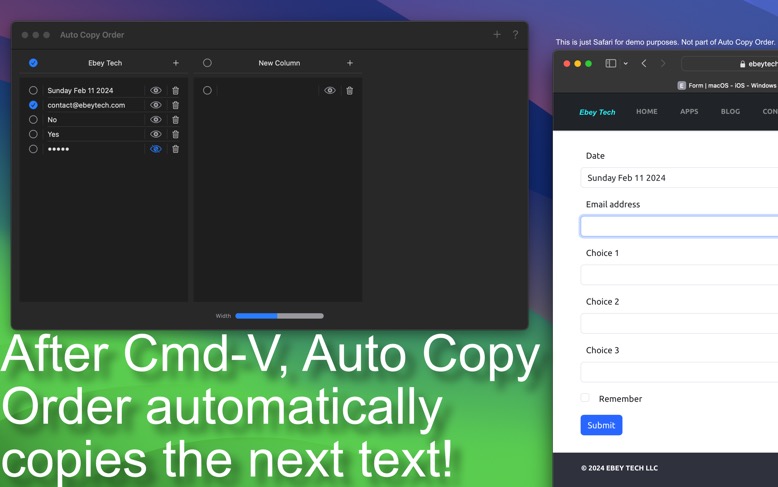
In order for 'Auto Copy Order' to detect when the 'V' key is pressed (user pasting via CMD-V), users will need to add 'Auto Copy Order' to the approved list of Accessibility Control. This setting is located under - Apple Menu > System Settings > Privacy & Security > Accessibility. Click the + button at the bottom, browse to the 'Auto Copy Order' app, then click Open. Auto Copy Order app will then be listed under the Accessibility control list. Verify the toggle button is ON. Finally restart Auto Copy Order app.
Click the + button in the toolbar to create a new Column Item.
Columns appear in a horizontal view. New Columns are inserted at the far left. Double-click the column name to rename the column. Right-click the column name to see context menu options for Rename and Delete. Each Column has a checkmark to their left, this activates which Column is currently active to provide automatic text copying to the clipboard. Clicking the checkmark also deactivates the Column. Right click a Column name and choose Reorder to access a list of Columns to be reordered.
Click a Column's + button to create new List Items.
Each List Item has a checkmark, a text field, and a delete button. Click in the center area or on an existing text string to modify a List Item's text. Click the far left checkmark to activate a List Item for automatic copying to clipboard. Click the Delete button to remove a List Item (holding option when clicking will Delete without Delete confirmation). Reorder List Items by dragging them to new positions.
Once you have your Column's List Items filled out with the appropriate text you want, click either the starting List Item or click the Column's checkmark to store the text to the clipboard. Locate the desired text field (external to Auto Copy Order) and press system CMD-V to initiate a paste operation. Auto Copy Order will detect (100ms detection rate) the keyboard shortcut was used and shift down to the next List Item, automatically copying its text string to the clipboard. Repeat operation. Auto Copy Order will loop back to the top List Item once it reaches the bottom of list.
The Mask button for each item obscures the text field characters, which can be useful when you need to hide text from view. Text content will still be copied in normal string format (unobscured).
Slideshow Music Player for Windows now Available
01/30/2024 Filed in: Slideshow Music Player

I finished development for Slideshow Music Player and it is now live in the Microsoft App Store.
Play music and view an image slideshow at the same time using Slideshow Music Player. Choose a music directory (optionally include sub-directory content) and click play to start playing music. Choose an image directory (optionally include sub-directory content) and click play to start playing an image slideshow. Adjust image delay to show an image for x amount of seconds. Double-click image preview to view a larger image slideshow, taking up the extent of the app window.
Music:
1.) Click bottom left music directory icon.
2.) Choose whether to include sub-directory content or not. Helpful when music is nested in folder sub-directories.
3.) Verify music is listed in listview.
4.) Click music controls play button.
Slideshow::
1.) Click image directory icon, right-side of view, left-most icon.
2.) Choose whether to include sub-directory content or not. Helpful when images are nested in folder sub-directories.
3.) Verify images are listed in listview. For sufficient slideshow, it is recommended to have a higher image count, like 50 images. Fewer images like 1-2, defeats the purpose of the slideshow.
4.) Click image controls play button.
5.) Slideshow starts with small preview in image controls section. Double-click image to view larger window size image slideshow. Double-click large window view to collapse to smaller preview.
6.) Adjust image delay to desired value, 1 to 60 seconds. Recommend 5-10 seconds delay.
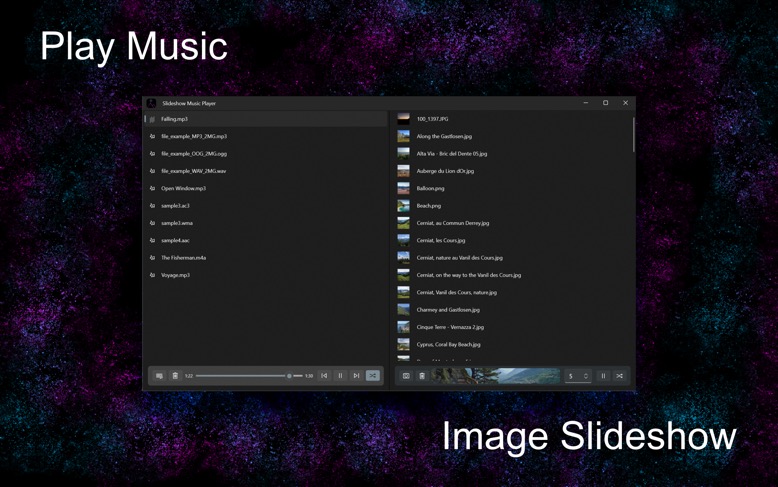
Slideshow Music Player in Development
01/15/2024 Filed in: Slideshow Music Player
I recently started development on a new Windows app called Slideshow Music Player. The purpose of this app is to play music and have a visual display of images from a selected directory. The images will display in a tiny view in the bottom right corner, but when double-clicked, will resize to fill the window. Double-clicking the full window view will again resize the image, back to its small form.


2 Point Scaler for iOS Now Available!
12/30/2023 Filed in: 2 Point Scaler

2 Point Scaler takes an input and converts it from one range to another scaled range. For example you could convert an input value from Celsius to Fahrenheit and view the converted output. Or convert an input value from a 4-20mA signal to a 0-50 psi value.
For conversion to work properly, minimum values should be less than maximum values for both input setpoints and scale setpoints.
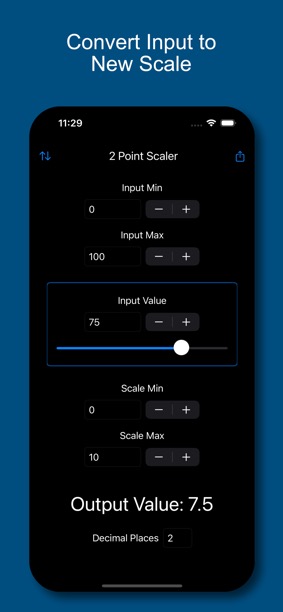
2 Point Scaler for macOS Now Available!
12/20/2023 Filed in: 2 Point Scaler

2 Point Scaler takes an input and converts it from one range to another scaled range. For example you could convert an input value from Celsius to Fahrenheit and view the converted output. Or convert an input value from a 4-20mA signal to a 0-50 psi value.
For conversion to work properly, minimum values should be less than maximum values for both input setpoints and scale setpoints.
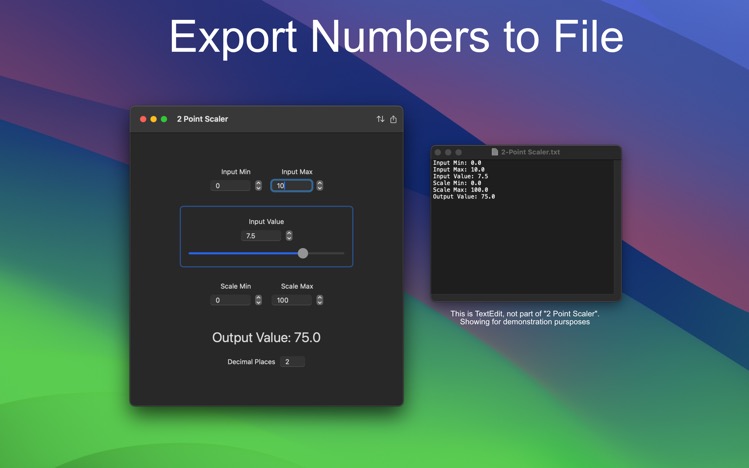
Auto Copy Order for macOS in Development
12/19/2023 Filed in: Auto Copy Order
I am working on a new macOS app aimed at helping users iterate through text content for pasting from the clipboard. When autofill isn't available it can sometimes be frustrating copying pasting content, having to switch back and forth between apps. Auto Copy Order helps with those situations by providing a list of text that is incrementally and automatically copied to the clipboard when the user presses CMD-V.
Working on a 2 Point Scaler App for macOS & iOS
12/17/2023 Filed in: 2 Point Scaler
I started development on a 2 Point Scaler app for macOS & iOS. The purpose of this app is to convert an input of a certain range to a new scale, then output the result. For example if you have an input that is a 4-20 mA sensor and you want to convert the input value from 0-50 psi. This app will produce the output value. Another example is converting Celsius to Fahrenheit, input min/max of 0-100 and scaling between 32-212.
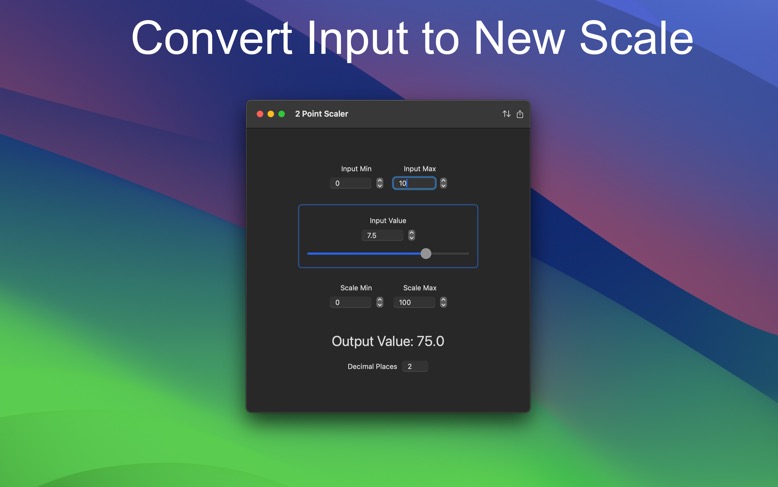

Create Checklists using Simple Week Checklist for macOS
12/06/2023 Filed in: Simple Week Checklist

Some tasks should be tracked simply. Use Simple Week Checklist to track weekly task status. At the start of a new week, clear checklists and start again. Simple Week Checklist makes simple work of everyday checklists, from work, to family to chores - track your simple tasks using Simple Week Checklist.
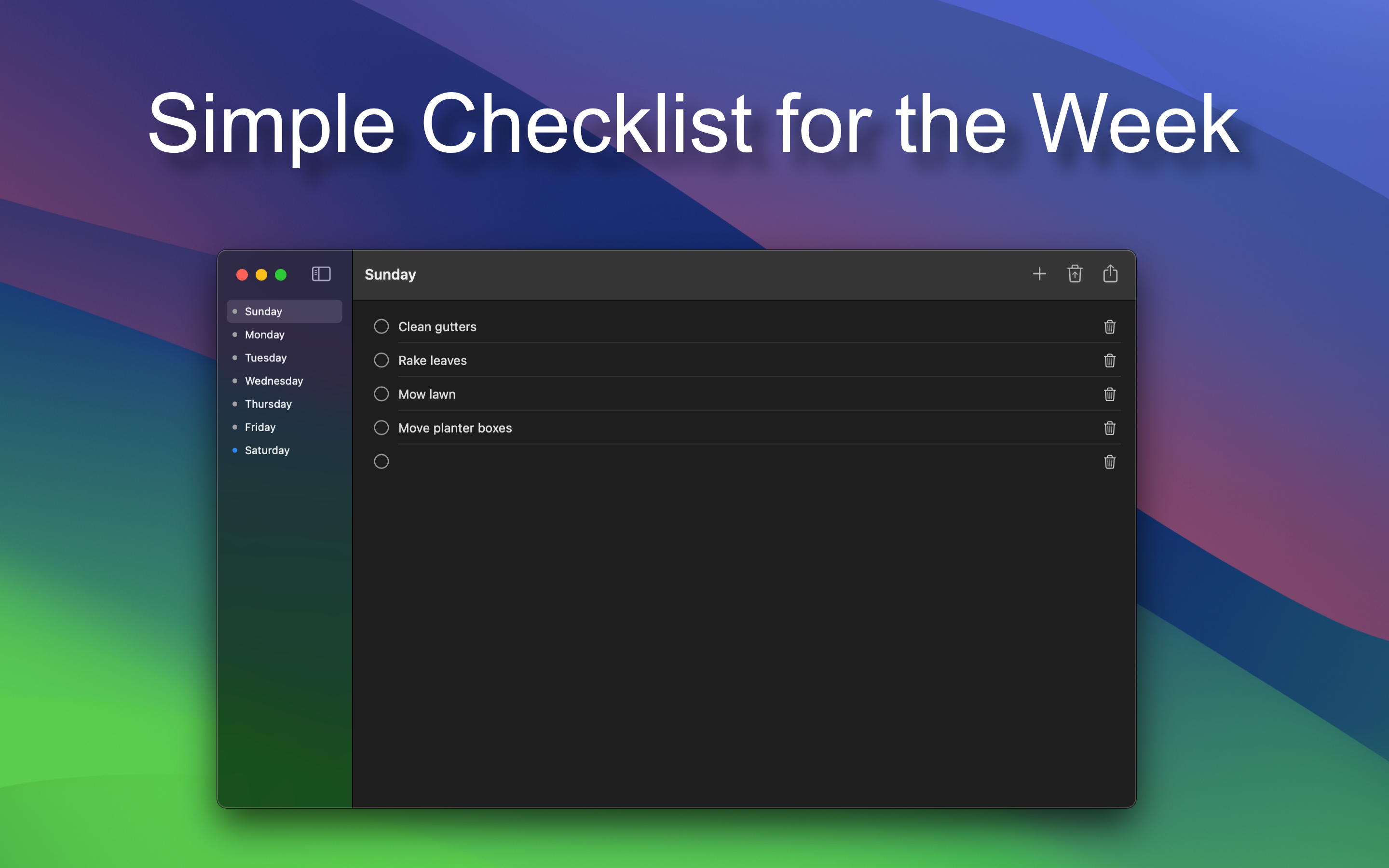
App Window Switcher for Windows Now Available
12/03/2023 Filed in: App Window Switcher
Create Checklists using Simple Week Checklist for iOS
12/05/2023 Filed in: Simple Week Checklist

Some tasks should be tracked simply. Use Simple Week Checklist to track weekly task status. At the start of a new week, clear checklists and start again. Simple Week Checklist makes simple work of everyday checklists, from work, to family to chores - track your simple tasks using Simple Week Checklist.

Updates to Simple Week for macOS
12/04/2023 Filed in: Simple Week
App Window Switcher for Windows in Development
11/15/2023 Filed in: App Window Switcher
I started work on a new Windows app called "App Window Switcher". The purpose of the app is to assign shortcut keys to apps. This app was suggested from a frequent customer from Germany who I have been corresponding with for a while now.
The app is being developed on Microsoft's WInUI framework, using Visual Studio 2022.
I anticipate the app taking a few weeks to develop.
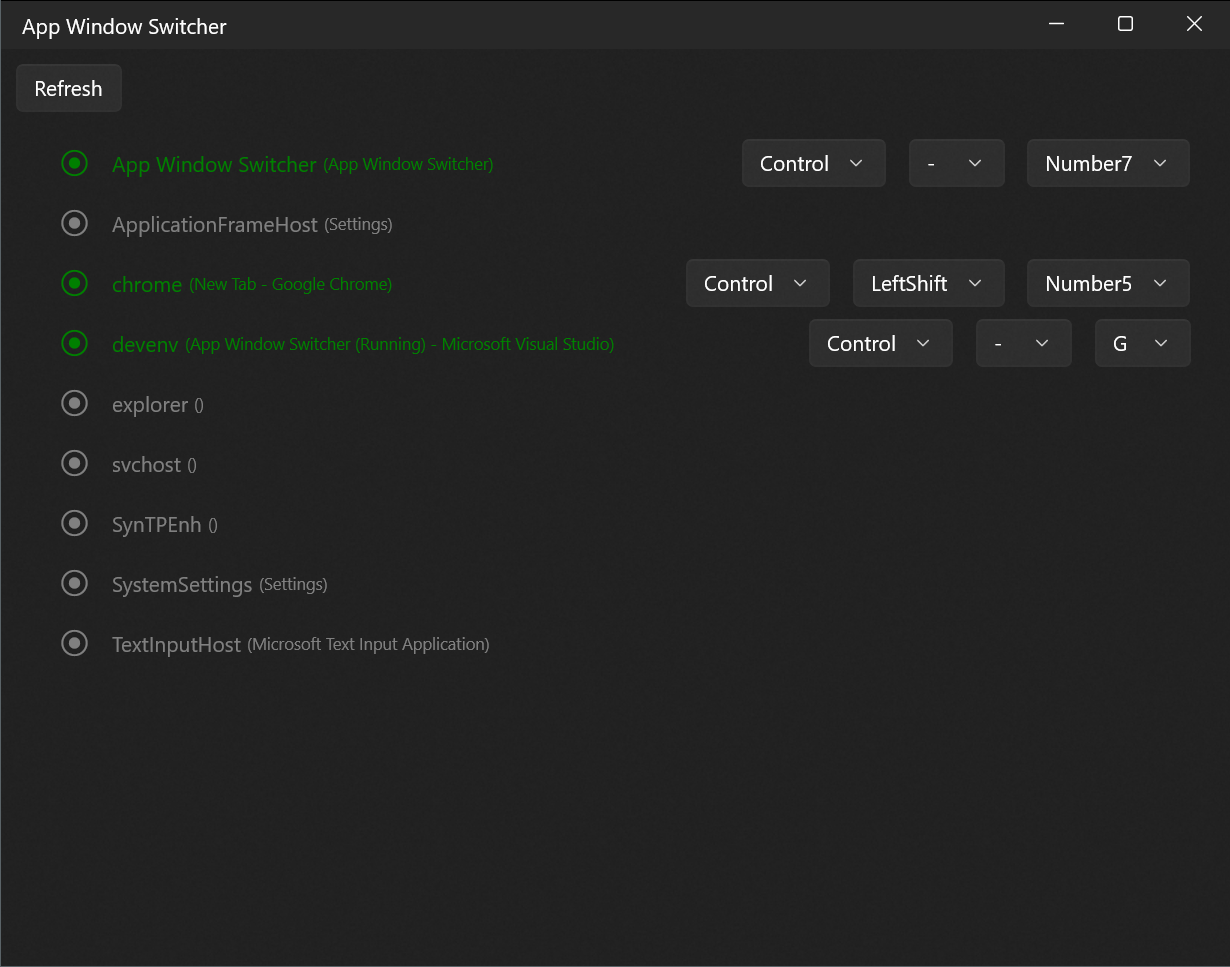
The app is being developed on Microsoft's WInUI framework, using Visual Studio 2022.
I anticipate the app taking a few weeks to develop.

Simple Week Routine for iOS- Now Available!
11/12/2023 Filed in: Simple Week Routine

Wakeup and accomplish more with Simple Week Routine. An app designed specifically to quickly track your "Routine" progress throughout the week. Simple Week Routine allows for fast creation of routines and powerful tools for accomplishing your routine goals.
Sign-in to iCloud account for data to store to iCloud.
Instructions for App Operation:
1.) Click the + at the top of navigation to add a new Group.
2.) Enter in a Group Item Name.
3.) Select a color. The furthest left color (white/black) is the system primary color. Depending on light/dark mode, this color may appear different.
4.) Click Add button to create the new Group.
5.) Click the newly created Group. The main view will load with days of the week.
6.) In the Toolbar, toggle the S, M, etc… buttons to hide/show days of the week. This can be useful for focusing on specific days of the week. For iPhone, rotate to landscape to see buttons.
7.) Click the + button in the main view’s toolbar to add a new Routine.
8.) Enter in a Routine Item Name.
9.) Toggle the S, M, etc… days of the week toggle buttons. When creating a new Routine, it’ll be listed under whatever days of the week are toggle active (blue).
10.) Use the M-F link button to automatically activate the Monday-Friday toggle buttons.
11.) Set an appropriate Routine Start Time for when your Routine is to be accomplished.
12.) Click Add button to create the new Routine.
13.) New Routines are added to the main view’s days of the week.
14.) To mark a Routine as complete, check the Routine’s checkbox (square).
15.) To edit Routines, double-tap any Routine. This will load the editor, which is similar to the Add Routine prompt. For example if Tuesday was toggled on, toggling it again will turn it off and remove the Routine from that day of the week in the main view.
16.) Clicking the Delete Routine button in the editor will remove the Routine from all days of the week and from the app.
17.) In the main view toolbar, clicking the Clear Checkboxes button will uncheck all Routine’s checkboxes. This can be useful when starting a new week and you want to clear previous week’s progress.
18.) In the main view, swiping downward will reveal the Search field. Type in desired text content to filter the days of the week for Routines matching similar text by Routine Name.
19.) In the main view, double-tap a day of the week to toggle a UI focus on that day’s Routines. This can be helpful to further focus on content. Double-tap it again to return UI to normal.
20.) Tap-hold (force-touch) a day of the week’s name to see additional functions. Check All will check all Routines for that day of the week. Uncheck All works the same. Delete All Routines will remove Routines for that day of the week.
21.) Tap-hold (force-touch) options for a day of the week when using “All Groups” work a bit differently. The Check All function will apply to all Groups for that day of the week. Same for Uncheck All. Additionally when using All Groups and performing Tap-hold (force-touch) option Delete All Routines, it will remove all Routines for all Groups on that day of the week. Care should be taken when using these global functions as they can impact multiple items in one operation.
22.) Tap-hold (force-touch) a Group to Edit or Delete the Group. Editing allows for name and color change. Deleting a Group will also delete all of it’s Routines, so care should be taken when using.
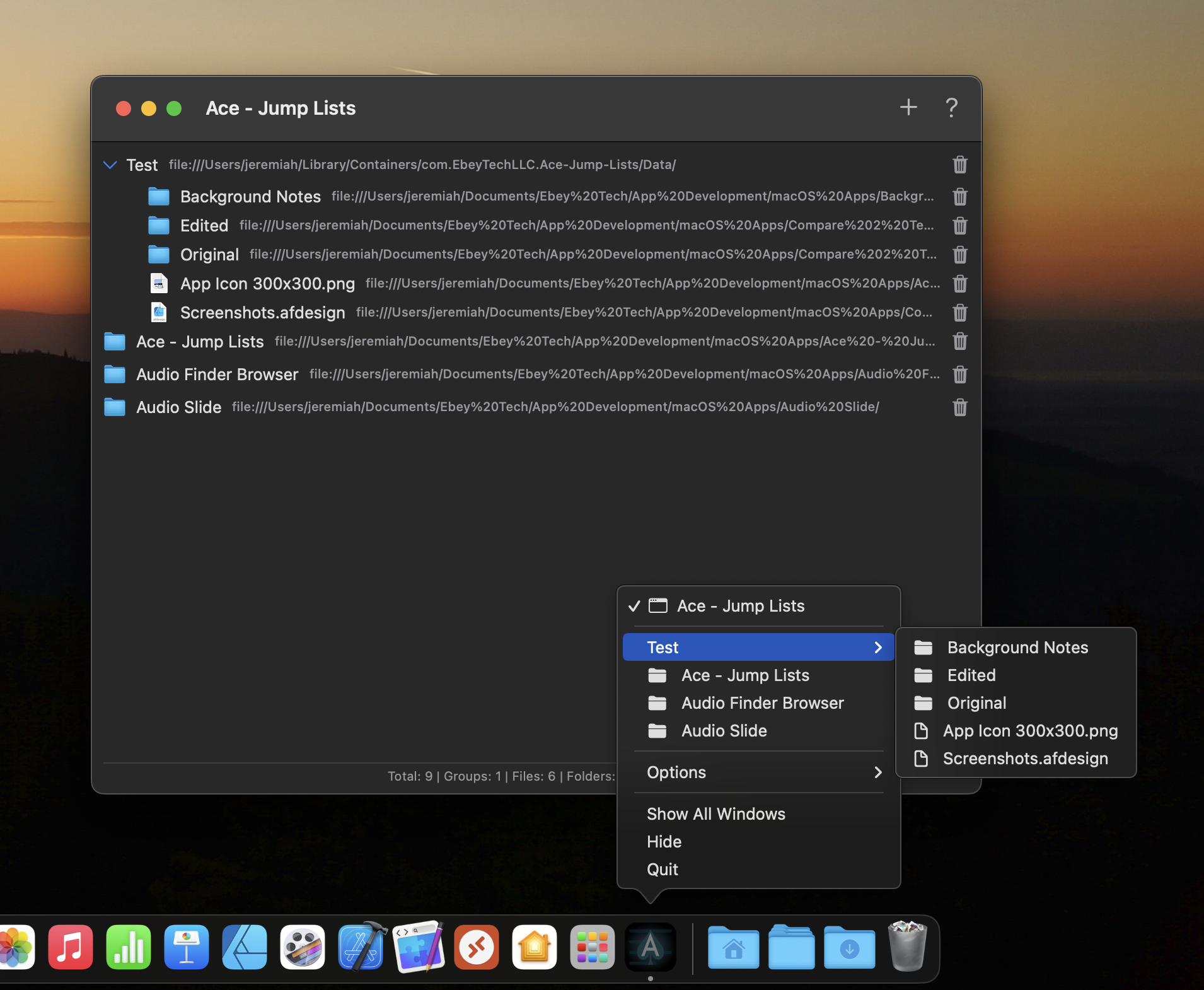
Simple Week Routine for macOS- Now Available!
10/31/2023 Filed in: Simple Week Routine

Wakeup and accomplish more with Simple Week Routine. An app designed specifically to quickly track your "Routine" progress throughout the week. Simple Week Routine allows for fast creation of routines and powerful tools for accomplishing your routine goals.
Instructions for App Operation:
1.) Click the + at the top of navigation to add a new Group.
2.) Enter in a Group Item Name.
3.) Select a color. The furthest left color (white/black) is the system primary color. Depending on light/dark mode, this color may appear different.
4.) Click Add button to create the new Group.
5.) Click the newly created Group. The main view will load with days of the week.
6.) In the Toolbar, toggle the S, M, etc… buttons to hide/show days of the week. This can be useful for focusing on specific days of the week.
7.) Click the + button in the main view’s toolbar to add a new Routine.
8.) Enter in a Routine Item Name.
9.) Toggle the S, M, etc… days of the week toggle buttons. When creating a new Routine, it’ll be listed under whatever days of the week are toggle active (blue).
10.) Use the M-F link button to automatically activate the Monday-Friday toggle buttons.
11.) Set an appropriate Routine Start Time for when your Routine is to be accomplished.
12.) Click Add button to create the new Routine.
13.) New Routines are added to the main view’s days of the week.
14.) To mark a Routine as complete, check the Routine’s checkbox (square).
15.) To edit Routines, double-click any Routine. This will load the editor, which is similar to the Add Routine prompt. For example if Tuesday was toggled on, toggling it again will turn it off and remove the Routine from that day of the week in the main view.
16.) Clicking the Delete Routine button in the editor will remove the Routine from all days of the week and from the app.
17.) In the main view toolbar, clicking the Clear Checkboxes button will uncheck all Routine’s checkboxes. This can be useful when starting a new week and you want to clear previous week’s progress.
18.) Click the Search field in the toolbar and type in desired text content to filter the days of the week for Routines matching similar text by Routine Name.
19.) In the main view, double-click a day of the week to toggle a UI focus on that day’s Routines. This can be helpful to further focus on content. Double-click it again to return UI to normal.
20.) Right-click a day of the week’s name to see additional functions. Check All will check all Routines for that day of the week. Uncheck All works the same. Delete All Routines will remove Routines for that day of the week.
21.) Right-click options for a day of the week when using “All Groups” work a bit differently. The Check All function will apply to all Groups for that day of the week. Same for Uncheck All. Additionally when using All Groups and performing right-click option Delete All Routines, it will remove all Routines for all Groups on that day of the week. Care should be taken when using these global functions as they can impact multiple items in one operation.
22.) Right-click a Group to Edit or Delete the Group. Editing allows for name and color change. Deleting a Group will also delete all of it’s Routines, so care should be taken when using.
Ace - Jump Lists for Windows in Development
10/28/2023 Filed in: Ace - Jump Lists
I started working on a Windows version of Ace - Jump Lists. It will fashion very similar to its macOS version.
Features:
The app will likely take several more weeks to finish development on. There are some specific Jump Item operations built-in to Windows that I am testing further.
Example screenshot:

macOS version for comparison:

Features:
- Main app window
- List of Jump Items.
- Ability to add and delete Jump Items.
- Ability to add Files, Folders, and URLs. No Group support like in the macOS version.
- Ability to right-click Taskbar and launch Files, Folders, and URLs.
The app will likely take several more weeks to finish development on. There are some specific Jump Item operations built-in to Windows that I am testing further.
Example screenshot:

macOS version for comparison:

Compare 2 Text for macOS Update v1.4
10/28/2023 Filed in: Compare 2 Text
Create Custom Dock Menus Using Ace - Jump Lists for macOS
10/28/2023 Filed in: Ace - Jump Lists

Ace - Jump Lists gives users the power to create awesome easily accessible and FAST Dock Menus! Everyone agrees, the Dock Menu is the fastest way to access content on macOS systems, because the Dock is always there, but Dock Menus are dependent on recent files and folders that serve the app ONLY. Ace - Jump Lists changes that by allowing for customizable Dock Menus! Users can now place whatever Files, Folders, or even website URLs they want in the Dock Menu. This changes everything!
To utilize Ace - Jump Lists’ Dock Menu features, the Ace - Jump Lists app MUST be running. It CAN be minimized or hidden though, so it appears out of sight.
Click the '+' button to add a new Jump Item. Jump Items can be a Group, File/Folder, or a URL. If adding a Group, click Group, enter in a Group Name, then click Add button. If adding a File/Folder, click File/Folder, if you have already created a Group, you can select a 'Parent' (Group). This will nest your new File/Folder under that Group. If you've selected a Group and change your mind, click on Group or URL to clear the UI selections, then you can click File/Folder again and the Parent field should be cleared. To browser to a File/Folder, click 'Add' button. This will launch the macOS Finder File/Folder picker. Choose whatever items needed. You can also select multiple Files/Folders. Click 'Open' when complete. New items are added to the main view list.
Ace - Jump Lists supports drag/drop for Files and Folders from macOS Finder. Locate desired File/Folder, then drag to Ace - Jump Lists. Drop either over the blank UI canvas, or existing Files/Folders, or drop on top of a Group. Dropping over canvas or existing Files/Folders will place the content at the root level of the list. Dropping over a Group will nest the content under the Group.
Ace's primary mechanism to usefulness is the Dock menu. Any content built out (Groups, Files/Folders, URLs) will be ported automatically over to the Dock menu. Access the Dock menu by right-clicking the Ace app icon. There, all items mirroring the Ace main UI list will be present. You can click on whatever item you want to 'launch' the content.
In Ace's main view list, double-click a File/Folder/URL 'name' to launch the content. Clicking on the icon or path will NOT launch the content. From the Dock menu right-click app icon, click any item to launch the content. For Groups, hovering over the menu item will expand its list of children (if it has any).
From the main view list, right-click any item and choose 'Edit' menu item. This will launch the item's appropriate type editing view. For Groups, there will be the 'name' field. Type in appropriate name and click 'Done' button. If you want to revert to original value, use 'Edit / Undo Typing' (or CMD-Z shortcut). For editing File/Folder parents', the Editing view will show a list of available Groups. Select a Group or click the 'Clear Parent' to not nest item in a Group. URLs can be edited in the same manner, enter in a label and URL. URLs are NOT verified, so be sure to enter in valid website URLs.
Click the Delete Button (trash can icon) to remove a Jump Item. To bypass the Delete confirmation prompt - hold down the 'option' key and click Delete Button. Delete is also available from each Jump Items' right-click menu. Hold 'option' key while clicking that Delete menu will also bypass the Delete Confirmation prompt.
Ace - Jump Lists for macOS
10/06/2023 Filed in: Ace - Jump Lists
I am working on a dock menu builder app for macOS called Ace - Jump Lists. Ace allows users to build-out their own custom dock menu using the Ace UI. Files, folders, and URLs can be inserted into Ace, their names are then ported over to the dock menu. Additionally users can insert a "Group" element and nest files, folders, and URLs in them.
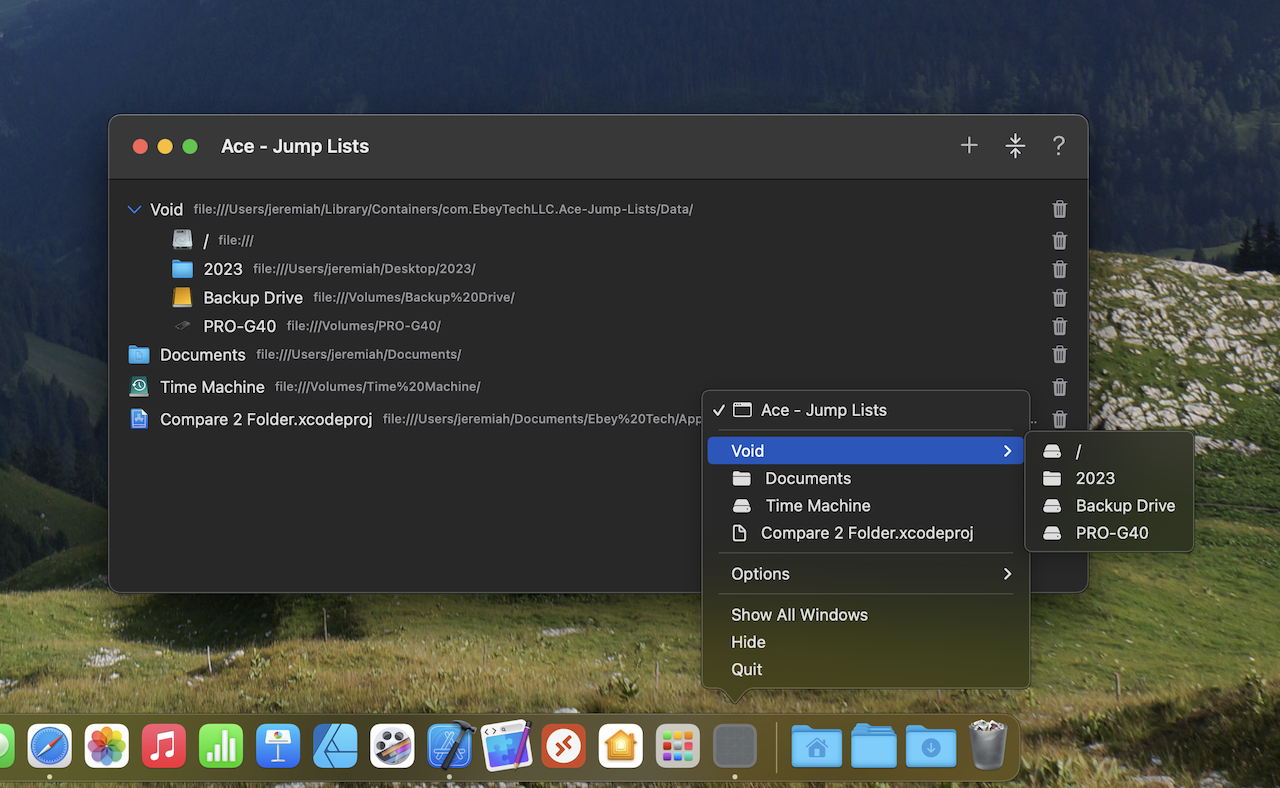

The Keywords for macOS - Now Available!
09/26/2023 Filed in: The Keywords

Use The Keywords app to assign keywords to files and folders. Utilize keywords to filter files & folders to access items fast and efficiently.
Click + button to create a new Tree Item. Click the Tree Item's + button to create new Keyword Items. In the navigation's toolbar, there are buttons for express operations, including Expand/Collapse Trees and Clear Keyword Selections. Tree Items can be Expanded/Collapse individually using the triangle next to them or by clicking the Tree Item Name. Tree Items have right-click options to Edit, Reorder, as well as some productivity buttons, for example turning the Group's Keywords on/off.
Keyword Items act like toggle button. Click them once to activate them. Click them again to de-activate them. Keyword Items have an important "key" feature for "Assigning Keywords" to a file/folder. A file/folder must be selected in the right-side Main View area before using the Assign Keywords functions. There are additional right-click features for Keyword Items too, like Clear Others - which de-activates other Keywords, and only activates the right-clicked Keyword.
Drag/drop file(s)/Folder(s) to the Main View (right-side area) to include files/folders in the app. Once a file/folder has been dropped and appears in the Main View, users can click to select it. To assign a Keyword to that File/Folder, with the file/folder selected, right-click a Keyword and choose "Assign Keywords". This links the Keyword to the selected file(s)/folder(s). After a Keyword has been assigned, clicking the Keyword would initiate the Main View to filter only files/folders that include the activated Keyword(s).
The Keywords app includes a toggle for filtering methods, referred to as "And-Logic" and "Or-Logic". And-Logic method would filter only files/folders that include ALL matching activated Keywords. Or-Logic method allows for filtering for ANY files/folders assigned to the activated Keywords.
For the Main View, along the top toolbar are optional toggles to hide/show file/folder properties, like Date Added and File Size. Date Added refers to the date of when the file/folder was dropped into The Keywords app. *Some files may not report a file size when read from the system. The macOS Finder may report the file's size, if true size is needed.
The Main View results can be sorted by Name or Date Added by clicking the Sort buttons along the bottom. The order can also be reversed by changing A-Z to Z-A.
The Keywords for macOS in Development
09/24/2023 Filed in: The Keywords
Working on a new macOS app called "The Keywords". This app allows users to drag/drop files/folders into the app and assign Keywords to them. Users can then use the keywords to filter specifically for target file/folder and then launch the item accordingly. Still doing some testing with the app to verify proper app operation. Also brainstorming some other similar keyword-based apps that focus on user productivity. Also considering porting The Keywords app to Windows.
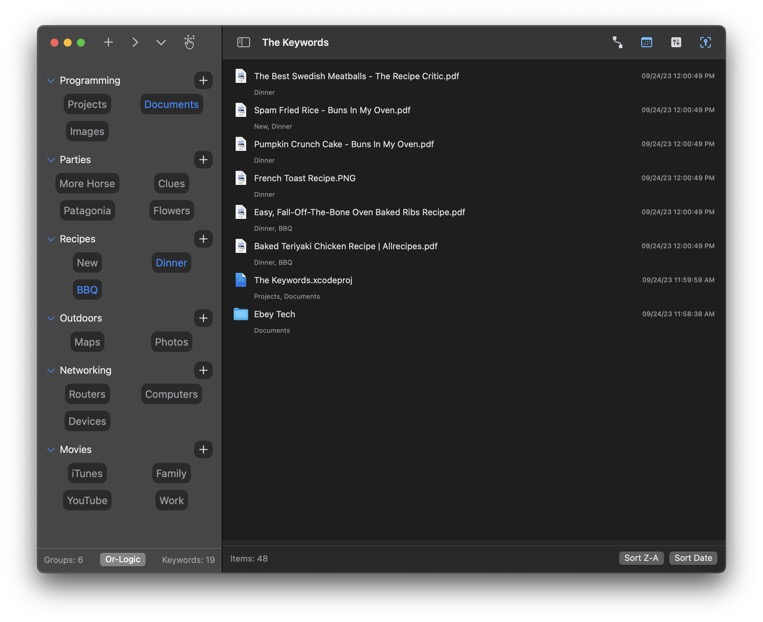

macOS Media Player App - Media Slide Blog
09/07/2023 Filed in: Media Slide

Media Slide is a great way to skim through an array of media files. Media files can be images, videos, music, or audio format.
Click the 'Choose Media Directory' button in toolbar to locate a directory containing media files (images, videos, audio). Typical image formats like png and jpg are supported. Typical video formats like mov and mp4 are supported. Typical audio files like mp3 and m4a are supported. If Quick Look can see/play it, it'll likely work. Media will be loaded into a background collection and default to showing the first media item from list. Media items in collection will be listed in alphabetical order.
Use the 'Clear App Data' button to remove the media directory reference from Media Slide app. Clear App Data doesn't affect any files stored on computer. Media Slide uses the Entitlement 'Access User Selected Files (Read Only)' - meaning it can't change any computer file data.
Use the Slider along the bottom to drag left/right. Moving the slider will switch between media files from the chosen directory. The Slider will only be visible if there are two or more media items. Optionally the left/right arrows in the bottom left corner can also be used to switch between media items. Those buttons also have a keyboard shortcut (left/right arrows respectively).
Along the bottom of the UI will show the selected media file name. Hovering above the media file name with the mouse cursor will show a tooltip of the media file path. To the bottom right corner lists the media directory count.
Right-click the media item's name and choose 'Show in Finder' to open the macOS Finder to the selected media item's directory.
macOS Music Player App - Audio Slide Blog
09/02/2023 Filed in: Audio Slide

Audio Slide is a great way to skim through an array of audio files and playback music, audio recordings, or sound effects.
Click the 'Choose Audio Directory' button in toolbar to locate a directory containing audio files. Typical audio files like mp3 and m4a are supported. If Quick Look can play it, it'll likely work. Audio will be loaded into a background collection and default to showing the first audio item from list. Audio items in collection will be listed in alphabetical order.
Use the 'Clear App Data' button to remove the audio directory reference from Audio Slide app. Clear App Data doesn't affect any files stored on computer.
Use the Slider along the bottom to drag left/right. Moving the slider will switch between audio files from the chosen directory. Slider will only be visible if there are two or more audio items.
Along the bottom of the UI will show the selected audio file name. Hovering above the audio file's name with the mouse cursor will show a tooltip of the audio file path. To the bottom right corner lists the audio directory count.
Right-click the audio item's name and choose 'Show in Finder' to open the macOS Finder to the selected audio item's directory.
Windows Recent Items App Blog
09/02/2023 Filed in: Recent Items

Recent Items offers a great way to see your Windows system built-in recent list for files and folders.
During Startup, Recent Items will read the user name currently logged in, then it'll append the standard Windows OS Recent directory path to the user name. This directory is where the Recent Items app pulls in .lnk files. It will then read and organize the .lnk file sources into Tree Items, based on Date Range groups. Shortcut files linking to server directories, like paths starting with '\\' are skipped. This is due to performance purposes. Reading from network sources drastically slows down recent file enumeration.
Click the Refresh button to clear the date range category lists and to reload content from the Recent directory. Pinned items are not reloaded, but will refresh any 'Write Time' values.
Recent items are categoried into multiple Date Ranges to provide an excellent recent file/folder experience. These Tree Items can be expanded/collapsed by click triangle icons, or by clicking Tree Item row (e.g. The Tree Item Name). Various right-click functions are available for Tree Items. The mainly provide batch operations for the Tree Items.
Files and folders work much like they would in File Explorer. Double-click to Open item. Right-click options to Recycle the source file/folder or to Delete the shortcut that appears in the user's Recent directory.
Click the Filter by Name field once to invoke the Filter History pop-up. Click the field again to change focus to the Filter field. Type in text into the Filter by Name field to dynamically filter Tree Items' content below. After about 4 seconds, any text in the Filter field will be added to the Filter History collection. Double-click a Filter History item to re-enter the text into the Filter field. Click the Clear button to clear all Filter History.
Use the provided built-in Filter icons in the toolbar to dynamically filter Link items below, based on item type. Right-click icons for additional batch operations (e.g. All On).
Toggle the Refresh Timer to have the Recent Items app attempt to dynamically update content in the Tree Item lists. Updates like date and assigned Date Range category will be processed.
Toggle the Delete Old button to choose to have Recent Items app attempt to purge the user's Recent directory of any shortcuts older than 1-year. This only affects shortcuts in the Recent directory and not their source content.
Better Clipboard Management in macOS
08/24/2023 Filed in: Floating Clipboard

Utilize Floating Clipboard for macOS to increase your productivity. Clipboard managers are a necessary tool for this day in modern computing. If you are struggling to constantly re-copy and re-paste text, images, and URL, checkout Floating Clipboard for macOS. Available on the Apple App Store!
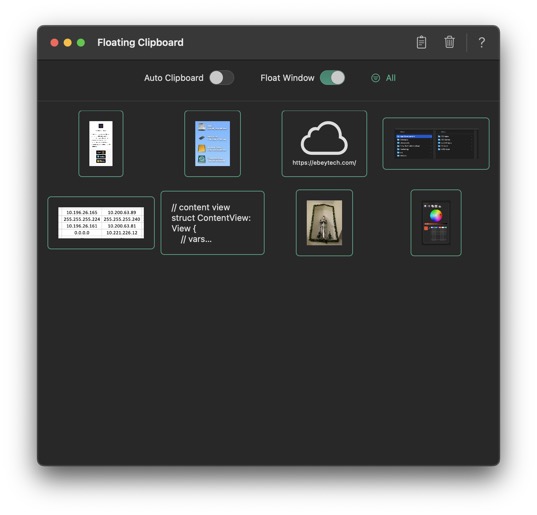
Floating Clipboard has a lot of great functionality, like Auto Clipboard, Float Window, and a powerful Image Viewer.
How to use Recent Items in Windows
08/24/2023 Filed in: Recent Items

Completed development for Video Slide for Windows.
Recent Items offers a great way to see your Windows system built-in recent list for files and folders.
During Startup, Recent Items will read the user name currently logged in, then it'll append the standard Windows OS Recent directory path to the user name. This directory is where the Recent Items app pulls in .lnk files. It will then read and organize the .lnk file sources into Tree Items, based on Date Range groups. Shortcut files linking to server directories, like paths starting with '\\' are skipped. This is due to performance purposes. Reading from network sources drastically slows down recent file enumeration.
Click the Refresh button to clear the date range category lists and to reload content from the Recent directory. Pinned items are not reloaded, but will refresh any 'Write Time' values.
Recent items are categoried into multiple Date Ranges to provide an excellent recent file/folder experience. These Tree Items can be expanded/collapsed by click triangle icons, or by clicking Tree Item row (e.g. The Tree Item Name). Various right-click functions are available for Tree Items. The mainly provide batch operations for the Tree Items.
Files and folders work much like they would in File Explorer. Double-click to Open item. Right-click options to Recycle the source file/folder or to Delete the shortcut that appears in the user's Recent directory.
Click the Filter by Name field once to invoke the Filter History pop-up. Click the field again to change focus to the Filter field. Type in text into the Filter by Name field to dynamically filter Tree Items' content below. After about 4 seconds, any text in the Filter field will be added to the Filter History collection. Double-click a Filter History item to re-enter the text into the Filter field. Click the Clear button to clear all Filter History.
Use the provided built-in Filter icons in the toolbar to dynamically filter Link items below, based on item type. Right-click icons for additional batch operations (e.g. All On).
Toggle the Refresh Timer to have the Recent Items app attempt to dynamically update content in the Tree Item lists. Updates like date and assigned Date Range category will be processed.
Toggle the Delete Old button to choose to have Recent Items app attempt to purge the user's Recent directory of any shortcuts older than 1-year. This only affects shortcuts in the Recent directory and not their source content.
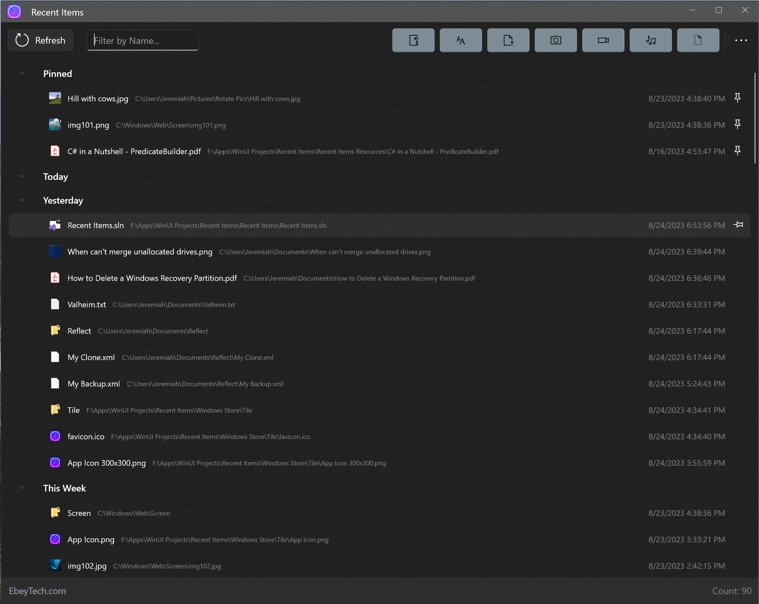
How to Skim through Videos using Video Slide for Windows
08/23/2023 Filed in: Video Slide

Completed development for Video Slide for Windows.
Video Slide is a great way to skim through an array of videos.
Click the 'Choose Video Directory' button in toolbar to locate a directory containing video files. Videos will be loaded into a background collection and default to showing the first video from list. Videos in collection will be listed in alphabetical order. Care should be taken to choose a location with an appropriate video quantity. The more videos in a directory the slower the processing time. Fewer videos like in the range of 20-60, make for a better experience.
Use the 'Clear App Data' button to remove the video directory reference from Video Slide app. Clear App Data doesn't affect any files stored on computer. Video Slide uses the Entitlement 'Access User Selected Files (Read Only)' - meaning it can't change any computer file data.
Use the Slider along the bottom to drag left/right. Moving the slider will switch between videos from the chosen directory. Slider will only be visible if there are two or more videos.
Along the bottom of the UI will show the selected video name. Hovering above the video name with the mouse cursor will show a tooltip of the video path. To the bottom right corner lists the video directory count.
Right-click video and choose 'Open File Location' to open the Windows File Explorer to the selected video's directory.
Recent Items for Windows
08/16/2023 Filed in: Recent Items
Working on a new app for Windows called Recent Items. This app ties into Windows' user's AppData folder for recent items. Incorporating a lot of filtering functionality into the app, like TreeView date categories, filter by name textbox, and type driven filtering button in toolbar. Hoping to launch this app sometime in early September.
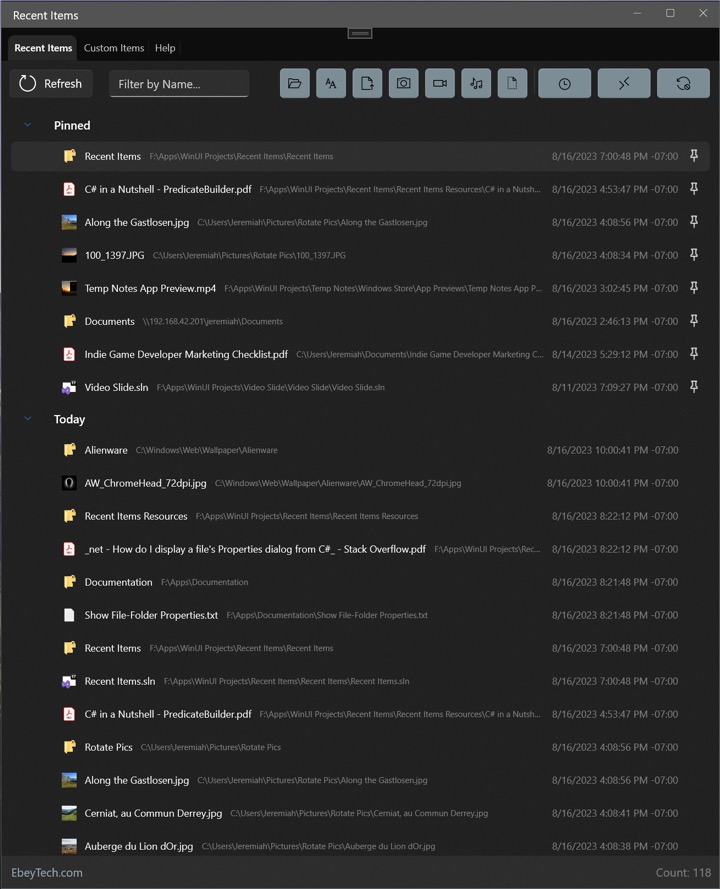

Temp Notes for Windows
08/07/2023 Filed in: Temp Notes

Completed development on Temp Notes for Windows.
Sometimes I find myself needing to jot some quick notes or capture a screenshot. A lot of times I don't intend to keep the content, but need it readily accessible for a bit. Information like IP addresses, ticket numbers, or a screenshot of data - fleeting data where I may just need it around for awhile, then it can be trashed. Temp Notes helps provide that solution. I can throw content into it and recall it up in the future if need be. I don't need to login to an app or web portal, or organize any files. Just throw it in! Temp Notes keeps 30 days of content, with the option to set elements to 'static', so they stick around longer and are persistent through the apps date ranges. Temp Notes provides a lot of useful features to make using it a no-brainer. Other apps just can't do what Temp Notes does so easily.
Features:
- Near infinite canvas
- Canvas panning
- Text Elements
- Image Elements
- Draggable Elements
- Slider for date target
- Calendar picker for date target
- Text Editor - with font size & color
- Image Viewer - with zoom to cursor
- Paste text/image
- Drag/drop images
- List View of Elements
- Internal Help Topics
- Fast Delete shortcuts
- Z indexing for Element layering
Create Temporary Notes for macOS using Temp Notes
07/03/2023 Filed in: Temp Notes

Sometimes I find myself needing to jot some quick notes or capture a screenshot. A lot of times I don't intend to keep the content, but need it readily accessible for a bit. Information like IP addresses, ticket numbers, or a screenshot of data - fleeting data where I may just need it around for awhile, then it can be trashed. Temp Notes helps provide that solution. I can throw content into it and recall it up in the future if need be. I don't need to login to an app or web portal, or organize any files. Just throw it in! Temp Notes keeps 30 days of content, with the option to set elements to 'static', so they stick around longer and are persistent through the apps date ranges. Temp Notes provides a lot of useful features to make using it a no-brainer. Other apps just can't do what Temp Notes does so easily.
Features:
- Near infinite canvas
- Canvas panning
- Text Elements
- Image Elements
- Draggable Elements
- Slider for date target
- Calendar picker for date target
- Text Editor - with font size & color
- Image Viewer - with zoom to cursor
- Paste text/image
- Drag/drop images
- List View of Elements
- Internal Help Topics
- Fast Delete shortcuts
- Z indexing for Element layering
Compare Files & Folder in Directories using Compare 2 Folder for Windows
07/03/2023 Filed in: Compare 2 Folder

Compare files and folders for directories. Compare by name, date modified, size, or all of the above. Fast filter options to display all results, just matches, or just non-matches. Ability to hide/show properties for date modified and size. Change how folders are displayed, either grouped at the top before files, or sort amongst files by alphabetical order. Use the Include Subfolders option to list all files and folders; including items nested inside other folders. Care should be taken using the subfolders option, as the processing time for comparison will be much longer for large lists.
Here are instructions for app operation:
1.) Launch app.
2.) Click button for Set Directory 1. Choose a directory for comparison. Directory should include files or folders.
3.) Click button for Set Directory 2. Choose a directory for comparison. Directory should include files or folders.
4.) The left/right lists will update to show files/folders and a comparison status green/red checkmark/x to indicate comparison results. A green checkmark indicates the item appeared in the other list. An X indicates no match was found for selected comparison parameter.
5.) Toggle toolbar buttons appropriately.
6.) Change 'Comparison' toolbar selection for desired comparison. E.g. choosing 'Name' will compare file/folder names between the two lists.
7.) Change 'Filter' for desired filtered result for Lists.
8.) Double-click a list's file/folder to launch the item. Not all files may be launchable due to Windows security.
9.) Right-click a list's file/folder to see 'Open' to launch the item. Not all files may be launchable due to Windows security.
10.) Right-click path-bar along bottom to see 'Open' to open the path location in File Explorer.
Skim through Videos using Video Slide for macOS
07/03/2023 Filed in: Video Slide

Video Slide is a great way to skim through an array of videos.
Click the 'Choose Video Directory' button in toolbar to locate a directory containing video files. Videos will be loaded into a background collection and default to showing the first video from list. Videos in collection will be listed in alphabetical order. Care should be taken to choose a location with an appropriate video quantity. The more videos in a directory the slower the processing time. Fewer videos like in the range of 20-60, make for a better experience.
Use the 'Clear App Data' button to remove the video directory reference from Video Slide app. Clear App Data doesn't affect any files stored on computer. Video Slide uses the Entitlement 'Access User Selected Files (Read Only)' - meaning it can't change any computer file data.
Use the Slider along the bottom to drag left/right. Moving the slider will switch between videos from the chosen directory. Slider will only be visible if there are two or more videos. Optionally the left/right arrows in the bottom left corner can also be used to switch between videos. Those buttons also have a keyboard shortcut (left/right arrows respectively).
Along the bottom of the UI will show the selected video name. Hovering above the video name with the mouse cursor will show a tooltip of the video path. To the bottom right corner lists the video directory count.
Right-click video name and choose 'Show in Finder' to open the macOS Finder to the selected video's directory.
Quickly Copy Text With One Click - Static Copy for Windows
06/16/2023 Filed in: Static Copy

Quickly copy text with one click! Static Copy provides a user adjustable list of text, where any text can be copied either from the app's main window or the system notification area toolbar. Need to hide text characters? Use the masking button to quickly obscure any text from view. Reorder text entries in whatever order is needed.
Static Copy for macOS Update v1.3
05/23/2023 Filed in: Static Copy
Completed Static Copy update v1.3.
Added Label fields. Changed Delete behavior to confirm if Copy Text entered. Added check for if Control key down, then skip Confirm Deletion. Changed Reorder pop-up size to scale with main window. Added Help Topics.
Static Copy for Windows in Development
05/09/2023 Filed in: Static Copy
Currently working on a Windows version of Static Copy using Microsoft's newest framework, WinUI 3 utilizing the App SDK. Static Copy will be similar to the macOS version of the app by the same name.
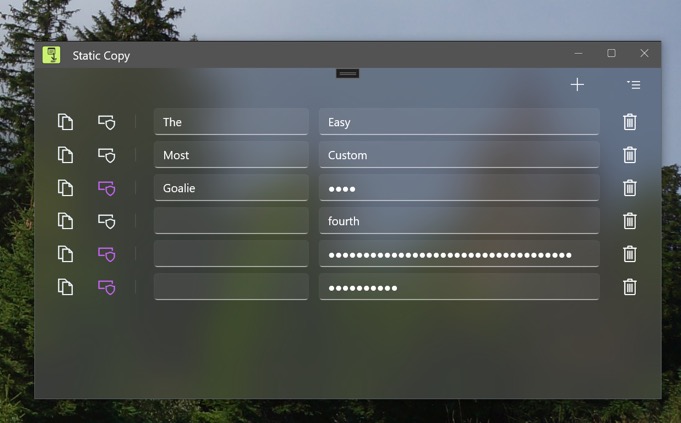
Resolved Issues:
Fixed crash due to icon not loaded. Fixed Acrylic Background not working. Fixed listview flickering.

Resolved Issues:
Skim through Images using Image Slide for Windows
05/04/2023 Filed in: Image Slide

Image Slide is a great way to skim through an array of images.
Click the 'Choose Image Directory' button in toolbar to locate a directory containing image files. Images will be loaded into a background collection and default to showing the first image from list. Images in collection will be listed in alphabetical order. Care should be taken to choose a location with an appropriate image quantity. The more images in a directory the slower the processing time. Fewer images like in the range of 20-60, make for a better experience.
Using File Explorer, drag some images and drop them onto Image Slide's app UI. Images will appear in the view and can be cycled to using the Slider control. Dropped images won't persist through app relaunches (use Directory Picker for that). If you had set an image directory and then drag/dropped some images, upon next app restart the image directory items will re-appear. If you wish to clear the image directory when drag/dropping different images, click the 'Clear App Data' button before drag/dropping new images.
Use the 'Clear App Data' button to remove the image directory reference from Image Slide app. Clear App Data doesn't affect any files stored on computer. Image Slide uses the Entitlement 'Access User Selected Files (Read Only)' - meaning it can't change any computer file data.
Use the Slider along the bottom to drag left/right. Moving the slider will switch between images from the chosen directory.
Along the bottom of the UI will show the selected image name. Hovering above the image name with the mouse cursor will show a tooltip of the image path. To the bottom right corner lists the image directory count.
Use mouse scroll to Zoom into the image.
Use left-mouse-click-hold + drag to pan around the image.
After zooming/panning, if you need to reset the image position, double-click the image. Keep in mind if the image is already at reset coordinates/zoom-level, double-clicking will launch the image.
Double-click the image to launch the image using its default application. Keep in mind if the image has been panned or zoomed, double-clicking will reset the image position.
Right-click image and choose 'Copy' to copy the image to the system pasteboard (clipboard).
Right-click image and choose 'Open File Location' to open the Windows File Explorer to the selected image's directory.
Skim through Images using Image Slide for macOS
04/19/2023 Filed in: Image Slide

Image Slide is a great way to skim through an array of images.
Click the 'Choose Image Directory' button in toolbar to locate a directory containing image files. Images will be loaded into a background collection and default to showing the first image from list. Images in collection will be listed in alphabetical order.
Using Finder, drag some images and drop them onto Image Slide's app UI. Images will appear in the view and can be cycled to using the Slider control. Dropped images won't persist through app relaunches (use Directory Picker for that). If you had set an image directory and then drag/dropped some images, upon next app restart the image directory items will re-appear. If you wish to clear the image directory when drag/dropping different images, click the 'Clear App Data' button before drag/dropping new images.
Use the 'Clear App Data' button to remove the image directory reference from Image Slide app. Clear App Data doesn't affect any files stored on computer.
Use the Slider along the bottom to drag left/right. Moving the slider will switch between images from the chosen directory.
Along the bottom of the UI will show the selected image name. Hovering above the image name with the mouse cursor will show a tooltip of the image path. To the bottom right corner lists the image directory count.
Use mouse scroll or trackpad pinch gesture to Zoom into the image.
Use left-mouse-click-hold + drag to pan around the image.
After zooming/panning, if you need to reset the image position, double-click the image. Keep in mind if the image is already at reset coordinates/zoom-level, double-clicking will launch the image.
Double-click the image to launch the image using its default application. Keep in mind if the image has been panned or zoomed, double-clicking will reset the image position.
Right-click image and choose 'Copy' to copy the image to the system pasteboard (clipboard).
Compare 2 Image for Windows Development Complete
04/08/2023 Filed in: Compare 2 Image
Compare images in directory or compare multiple directories using include subfolders toggle button. Comparison can be made by name, date modified, size, data, or all of the above to quickly identify images that are different. Further highlight images with a difference using built-in fast filter options for the display of all results, just matches, or non-matches. Images that don’t have a match will have a mark identifying them as a non-match. Ability to hide/show properties for date modified and size. Use the Include Subfolders option to list all images; including images nested inside other folders. Care should be taken using the subfolders option, as the processing time for comparison will be much longer for large lists.
Features:
- Compare images quickly.
- Images nested in subfolders can be compared.
- Multiple comparison methods; by name, date, size, and data.
- Preview images.
- Launch images in default app.
Here are instructions for app operation:
1.) Launch app.
2.) Click button for Set Directory 1. Choose a directory for comparison. Directory should include images.
3.) Click button for Set Directory 2. Choose a directory for comparison. Directory should include images.
4.) The left/right lists will update to show images and a comparison status green/red checkmark/x to indicate comparison results. A green checkmark indicates the item appeared in the other list. An X indicates no match was found for selected comparison parameter.
5.) Toggle toolbar buttons appropriately.
6.) Change 'Comparing' toolbar selection for desired comparison. E.g. choosing 'Name' will compare image names between the two lists.
7.) Change 'Filter' for desired filtered result for Lists.
8.) Double-click a list's image to see an image preview.
9.) Right-click a list's image to see 'Open' to launch the item.
10.) Right-click path-bar along bottom to see 'Open' to open the path location in File Explorer.
Features:
- Compare images quickly.
- Images nested in subfolders can be compared.
- Multiple comparison methods; by name, date, size, and data.
- Preview images.
- Launch images in default app.
Here are instructions for app operation:
1.) Launch app.
2.) Click button for Set Directory 1. Choose a directory for comparison. Directory should include images.
3.) Click button for Set Directory 2. Choose a directory for comparison. Directory should include images.
4.) The left/right lists will update to show images and a comparison status green/red checkmark/x to indicate comparison results. A green checkmark indicates the item appeared in the other list. An X indicates no match was found for selected comparison parameter.
5.) Toggle toolbar buttons appropriately.
6.) Change 'Comparing' toolbar selection for desired comparison. E.g. choosing 'Name' will compare image names between the two lists.
7.) Change 'Filter' for desired filtered result for Lists.
8.) Double-click a list's image to see an image preview.
9.) Right-click a list's image to see 'Open' to launch the item.
10.) Right-click path-bar along bottom to see 'Open' to open the path location in File Explorer.
Compare 2 Image for Windows in Development
04/04/2023 Filed in: Compare 2 Image
I am currently working on an app called Compare 2 Image. It will perform the same operations as its macOS cousin - Compare 2 Image for macOS.
I just finished the logic for image bytes comparison between two images. I also FINALLY got the async operations finished. The biggest hurdle was processing the image collection view using async Task logic, then waiting for its completion before running a comparison upon the 2 collections.
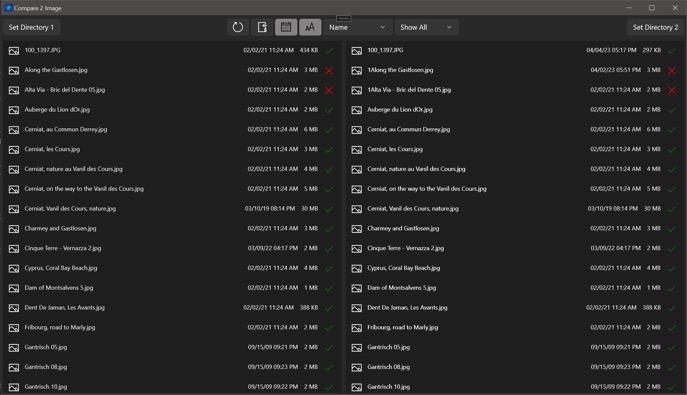
I just finished the logic for image bytes comparison between two images. I also FINALLY got the async operations finished. The biggest hurdle was processing the image collection view using async Task logic, then waiting for its completion before running a comparison upon the 2 collections.

How to Compare Images for macOS Using Compare 2 Image
03/21/2023 Filed in: Compare 2 Image

Compare images in directory or compare multiple directories using include subfolders toggle button. Comparison can be made by name, date modified, size, data, or all of the above to quickly identify images that are different. Further highlight images with a difference using built-in fast filter options for the display of all results, just matches, or non-matches. Images that don’t have a match will have a mark identifying them as a non-match. Ability to hide/show properties for date modified and size. Use the Include Subfolders option to list all images; including images nested inside other folders. Care should be taken using the subfolders option, as the processing time for comparison will be much longer for large lists.
Features:
- Compare images quickly.
- Images nested in subfolders can be compared.
- Multiple comparison methods; by name, date, size, and data.
- Preview images.
- Launch images in default app.
Here are instructions for app operation:
1.) Launch app.
2.) Click button for Set Directory 1. Choose a directory for comparison. Directory should include images.
3.) Click button for Set Directory 2. Choose a directory for comparison. Directory should include images.
4.) The left/right lists will update to show images and a comparison status green/red checkmark/x to indicate comparison results. A green checkmark indicates the item appeared in the other list. An X indicates no match was found for selected comparison parameter.
5.) Toggle toolbar buttons appropriately.
6.) Change 'Comparing' toolbar selection for desired comparison. E.g. choosing 'Name' will compare image names between the two lists.
7.) Change 'Filter' for desired filtered result for Lists.
8.) Double-click a list's image to see an image preview.
9.) Right-click a list's image to see 'Open' to launch the item.
10.) Right-click pathbar along bottom to see 'Open' to open the path location in Finder.
Use Examples:
- Compare images on local disk to a backup directory on another disk.
- Confirm images have been copied to a location by a specific date.
- Determine image sizes for directories.
- See all images from a root folder through all subfolders.
Test Multiple SMTP Connections using Multi SMTP Checker
03/19/2023 Filed in: Multi SMTP Checker
Use Multi SMTP Checker to send a test e-mail to a recipient. SMTP stands for Simple Mail Transfer Protocol and can be used to send e-mails leveraging an SMTP provider. There are many SMTP providers available, several well known online search engines can provide them.
Enter in appropriate SMTP configuration and click Test Connection to test. If test completes successfully, a successful message prompt is seen and e-mail recipient will receive test e-mail. Multi SMTP Checker supports saving multiple Nav Items, think of them as profiles. This allows users to store multiple SMTP configuration for reference and testing.
Enter in appropriate SMTP configuration and click Test Connection to test. If test completes successfully, a successful message prompt is seen and e-mail recipient will receive test e-mail. Multi SMTP Checker supports saving multiple Nav Items, think of them as profiles. This allows users to store multiple SMTP configuration for reference and testing.
Clipboard History Manager for macOS - Floating Clipboard
03/16/2023 Filed in: Floating Clipboard

Use this app to take screenshots of content, then store them in the Floating Clipboard window. Now you can zoom in and focus on details using the built-in image viewer. Since Floating Clipboard floats above other apps and windows, the app can be tucked into a Desktop corner and you can still reference the content with ease.
Also use this app to copy text and do similar operations like images. The built-in text editor has a 'Virtual Line' function to draw focus to desired content.
Finally, there is a built-in URL viewer to view pasted URL content from the web (with limited functions).
Features:
-Clipboard history.
-Auto fetching of clipboard contents (optional).
-Float Window above other apps & windows (optional).
-Fast & fluid type-based filtering.
-Inserted content management.
-Editable text.
-Image Viewer with simple mouse-scroll zoom.
-URL Viewer for webpage viewing.
-Built-in Help Topics.
Instructions for Operation:
1.) Launch app.
2.) Optionally choose Auto Clipboard - used to automatically fetch clipboard contents (if image, text, or URL) and inserts into Floating Clipboard.
3.) Optionally choose Float Window - used to keep Floating Clipboard app UI above other apps & windows.
4.) Elsewhere in system copy image, text, or URL content via traditional means (e.g. use macOS screenshot command to take a snapshot).
5.) Once desired content is copied to system clipboard, use the Paste button in Floating Clipboard to insert the content. Or, if Auto Clipboard function is enabled, content will automatically be inserted without having to click Paste button.
6.) Repeat for other images, text, or URL if desired.
7.) Double-click an image, text, or URL inside Floating Clipboard to open either an editor/viewer (depending on clicked item).
8.) If double-clicking an Image item - an Image Viewer pop-up will show. If NOT using the optional 'VIew as PDF' mode, mouse-scroll will zoom in/out on image. Left-clicking + dragging will 'pan' image around. If using the 'View as PDF' mode active, zoom can be done by using shortcut command CMD & +/-. There are traditional right-click functions for PDF options too.
9.) If double-clicking a Text item - a Text Editor pop-up will show. Users can edit the text and click 'Complete' button to save changes. Or 'Cancel' button to discard changes. An optional 'Virtual Line' function is available to use as a mark to allow easier focusing on text content. The line can be moved up/down by left-clicking + dragging.
10.) If double-clicking a URL item - a URL viewer pop-up will show. Typical BUT limited browser operation can be achieved.
11.) Use the trash icon, Delete button in toolbar to Delete All items in grid view.
12.) Filtering can be achieved by clicking the 'All' link-button next to the filter icon. Filter for Image, Text, or URL can be performed. The filter link-button will cycle through the types and then loop back to 'All' to show all possible results.
Examples of Use:
-I use this app to screenshot content from other Mission Control screens and paste it into Floating Clipboard so I can zoom in on the data. With the window floating I can tuck it off to the side and still work on other tasks. Optionally Floating Clipboard (any app for that matter) can be set to appear on other Mission Control screens by right-clicking app's dock icon - Options - Assign to - "All Desktops".
That Text for Windows
03/15/2023 Filed in: That Text

That Text allows for quick data entry into text fields. Group text content into navigable entries to easily organize content. Click on a Nav Item to bring up previous text entries fast. Edit or reorder content using built-in context menus. Text entries can be shifted left/right to simulate a parent/child tree-like structure. A powerful Filter field allows for fast filtering of content. Filtering can be toggled between filtering by Text entry or Tree name.
Features:
- Editable navigation items.
- Stellar tree view to organize complex text lists.
- Great looking text fields that can be indented to form parent/child structures.
Instructions for app use:
1.) Launch app.
2.) Click + icon to create a new Navigation Item (Nav Item).
3.) Enter in a Nav Item name.
4.) Click newly created nav item.
5.) Main view loads. Click + icon in upper right to add new Tree Item. When pop up shows, enter a name.
6.) Click newly created Tree Item’s + icon. This creates Text fields for data entry.
7.) Type data into text fields. It auto saves content.
8.) Click move left/right arrows to adjust indent.
9.) Click ( - minus) icon to delete a text field. If text field has data, there will be a confirmation pop-up. If no data, the field is just removed.
10.) Right click on text field's buttons to see context options. For example right-clicking on minus (-) button will show more options.
10.1) Right-click options: Insert New Text Above/Below will insert a new text field either above current right-click location or below. Indentation of inserted items will match current indent of currently right-click item.
10.2) Reorder will show a pop-up view where user can drag/drop entries around in whichever desired order is wanted.
11.) Toolbar Reorder button will perform a similar task as the text field Reorder; although it will only show Tree items in list and they will be reordered to desired order.
12.) Toolbar chevrons for collapse all and expand all, this affects only Tree items under current Navigation item - unless using the "All Items" navigation, then all Tree Items for all Navigation Items will either expand or collapse.
13.) Right-click context options for Navigation items for editing Nav Item name, Reordering list, or deleting.
14.) Filter field at bottom left of main view - clicking the filter icon will cycle between either filtering by Text data or by Tree Item name. Toggle icon to appropriate choice and type into filter field. Data is dynamically filtered. Be sure to clear the filter when complete - changing to another Navigation item keeps the Filter text and will still actively attempt to filter content.
15.) Max Height slider affects only Text fields that have a lot of text content in them (usually a few rows of text). Changing the Max Height slider will "cap" the text content to specified height, triggering the vertical scrollbar to become active.
Use Examples:
-Document computer configuration
-Create notes regarding topics of interest
-List out your reminders.
-Record information regarding work tasks.
That Text for iOS
03/15/2023 Filed in: That Text

That Text allows for quick data entry into text fields. Group text content into navigable entries to easily organize content. Click on a Nav Item to bring up previous text entries fast. Edit or reorder content using built-in context menus. Text entries can be shifted left/right to simulate a parent/child tree-like structure. A powerful Filter field allows for fast filtering of content. Filtering can be toggled between filtering by Text entry or Tree name.
Features:
- Editable navigation items.
- Stellar tree view to organize complex text lists.
- Great looking text fields that can be indented to form parent/child structures.
Instructions for app use:
1.) Launch app.
2.) Click + icon to create a new Navigation Item (Nav Item).
3.) Enter in a Nav Item name.
4.) Click newly created nav item.
5.) Main view loads. Click + icon in upper right to add new Tree Item. When pop up shows, enter a name.
6.) Click newly created Tree Item’s + icon. This creates Text fields for data entry.
7.) Type data into text fields. It auto saves content.
8.) Click move left/right arrows to adjust indent.
9.) Click ( - minus) icon to delete a text field. If text field has data, there will be a confirmation pop-up. If no data, the field is just removed.
10.) Tap-hold on text field's buttons to right for context options. For example tap-holding on minus (-) button will show more options.
10.1) Tap-hold options: Insert New Text Above/Below will insert a new text field either above current tap-hold location or below. Indentation of inserted items will match current indent of currently tap-hold item.
10.2) Reorder will show a pop-up view where user can drag/drop entries around in whichever desired order is wanted.
11.) Toolbar Reorder button will perform a similar task as the text field Reorder; although it will only show Tree items in list and they will be reordered to desired order.
12.) Toolbar chevrons for collapse all and expand all, this affects only Tree items under current Navigation item - unless using the "All Items" navigation, then all Tree Items for all Navigation Items will either expand or collapse.
13.) Tap-hold context options for Navigation items for editing Nav Item name, Reordering list, or deleting.
14.) Filter field at bottom left of main view - clicking the filter icon will cycle between either filtering by Text data or by Tree Item name. Toggle icon to appropriate choice and type into filter field. Data is dynamically filtered. Be sure to clear the filter when complete - changing to another Navigation item keeps the Filter text and will still actively attempt to filter content.
Use Examples:
-Document computer configuration
-Create notes regarding topics of interest
-Record information regarding work tasks.
That Text for macOS
03/15/2023 Filed in: That Text

That Text allows for quick data entry into text fields. Group text content into navigable entries to easily organize content. Click on a Nav Item to bring up previous text entries fast. Edit or reorder content using built-in context menus. Text entries can be shifted left/right to simulate a parent/child tree-like structure. A powerful Filter field allows for fast filtering of content. Filtering can be toggled between filtering by Text entry or Tree name.
Features:
- Editable navigation items.
- Stellar tree view to organize complex checklists.
- Great looking text fields that can be indented to form parent/child structures.
Instructions for app use:
1.) Launch app.
2.) Click + icon to create a new Navigation Item (Nav Item).
3.) Enter in a Nav Item name.
4.) Click newly created nav item.
5.) Main view loads. Click + icon in upper right to add new Tree Item. When pop up shows, enter a name.
6.) Click newly created Tree Item’s + icon. This creates Text fields for data entry.
7.) Type data into text fields. It auto saves content.
8.) Click move left/right arrows to adjust indent.
9.) Click ( - minus) icon to delete a text field. If text field has data, there will be a confirmation pop-up. If no data, the field is just removed.
10.) Right click on text field's buttons to right for context options. For example right-clicking on minus (-) button will show more options.
10.1) Right-click options: Insert New Text Above/Below will insert a new text field either above current right-click location or below. Indentation of inserted items will match current indent of currently right-click item.
10.2) Reorder will show a pop-up view where user can drag/drop entries around in whichever desired order is wanted.
11.) Toolbar Reorder button will perform a similar task as the text field Reorder; although it will only show Tree items in list and they will be reordered to desired order.
12.) Toolbar chevrons for collapse all and expand all, this affects only Tree items under current Navigation item - unless using the "All Items" navigation, then all Tree Items for all Navigation Items will either expand or collapse.
13.) Right-click context options for Navigation items for editing Nav Item name, Reordering list, or deleting.
14.) Filter field at bottom left of main view - clicking the filter icon will cycle between either filtering by Text data or by Tree Item name. Toggle icon to appropriate choice and type into filter field. Data is dynamically filtered. Be sure to clear the filter when complete - changing to another Navigation item keeps the Filter text and will still actively attempt to filter content.
15.) Max Height slider affects only Text fields that have a lot of text content in them (usually a few rows of text). Changing the Max Height slider will "cap" the text content to specified height, triggering the vertical scrollbar to become active.
Use Examples:
-Document computer configuration
-Create notes regarding topics of interest
-List out your reminders.
-Record information regarding work tasks.
That Checklist for iOS Update v1.2
03/12/2023 Filed in: That Text
SMTP Checker for Windows
03/11/2023 Filed in: SMTP Checker

Finished development on SMTP Checker for Windows. It is now available via the Microsoft App Store.
Use SMTP Checker to send a test e-mail to a recipient. SMTP stands for Simple Mail Transfer Protocol and can be used to send e-mails leveraging an SMTP provider. There are many SMTP providers available, several well known online search engines can provide them.
Enter in appropriate SMTP configuration and click Test Connection to test. If test completes successfully, a successful message prompt is seen and e-mail recipient will receive test e-mail.
Multi SMTP Checker in Development
03/11/2023 Filed in: Multi SMTP Checker
How to Compare Text in Windows
03/04/2023 Filed in: Compare 2 Text
That Checklist for iOS
03/04/2023 Filed in: That Checklist

That Checklist allows for quick data entry into text fields and mark-off of checkboxes. Group checklists content into navigable entries to easily organize content. Click on a Nav Item to bring up previous checklists fast. Edit or reorder content using built-in context menus. Checklists can be shifted left/right to simulate a parent/child tree-like structure. A powerful Filter field allows for fast filtering of content. Filtering can be toggled between filtering by checklist text entry or Tree name.
Features:
- Editable navigation items.
- Stellar tree view to organize complex checklists.
- Great looking checklists that can be indented to form parent/child structures.
Instructions for app use:
1.) Launch app.
2.) Click + icon to create a new Navigation Item (Nav Item).
3.) Enter in a Nav Item name.
4.) Click newly created nav item.
5.) Main view loads. Click + icon in upper right to add new Tree Item. When pop up shows, enter a name.
6.) Click newly created Tree Item’s + icon. This creates checklist for data entry.
7.) Type data into text fields. It auto saves content. Click the checkbox to check-off items like a checklist.
8.) Click move left/right arrows to adjust indent.
9.) Click ( - minus) icon to delete a checklist. If text field has data, there will be a confirmation pop-up. If no data, the field is just removed.
10.) Tap-hold on checklist checkbox or the buttons to right for context options. For example tap-holding on minus (-) button will show more options.
10.1) Tap-hold options: Insert New Text Above/Below will insert a new checklist either above current tap-hold location or below. Indentation of inserted items will match current indent of currently tap-hold item.
10.2) Reorder will show a pop-up view where user can drag/drop entries around in whichever desired order is wanted.
11.) Toolbar Reorder button will perform a similar task as the checklist Reorder; although it will only show Tree items in list and they will be reordered to desired order.
12.) Toolbar chevrons for collapse all and expand all, this affects only Tree items under current Navigation item - unless using the "All Items" navigation, then all Tree Items for all Navigation Items will either expand or collapse.
13.) Tap-hold context options for Navigation items for editing Nav Item name, Reordering list, or deleting.
14.) Filter field at bottom left of main view - clicking the filter icon will cycle between either filtering by Text data or by Tree Item name. Toggle icon to appropriate choice and type into filter field. Data is dynamically filtered. Be sure to clear the filter when complete - changing to another Navigation item keeps the Filter text and will still actively attempt to filter content.
Use Examples:
-Verify the packing of camping supplies.
-Create to do lists for chores.
-List out your reminders.
-Document completion of work tasks.
How to Single Click Copy in macOS
02/05/2023 Filed in: Static Copy
Quickly copy text with one click! Static Copy provides a user adjustable list of text, where any text can be copied either from the app's main window or the embedded menu bar. Need to hide text characters? Use the masking button to quickly obscure any text from view. Reorder text entries in whatever order is needed.

Features:
-Create as many text entries as needed in list.
-One-click copying of text.
-Masking of text characters, so the text cannot be seen.
-Dedicated menu bar list, where text can be copied by single click of text. This can be done when Static Copy app is not focused too!
-Ability to change order of text entries in list.
Instructions for use:
1.) Launch app.
2.) Click the + button in upper right corner.
3.) In the newly created text field, enter in whatever text is desired.
4.) Click the checkmark button to "copy" the text to the clipboard. Icon momentarily reacts.
5.) Click the mask button to change the text to secure characters.
6.) Click the trash button to delete any text entries.
7.) Click the Static Copy menu bar up by the macOS system date/time. Click a text entry to copy the text to the clipboard.
8.) Click the Reorder button in the Static Copy app's window, up by the + icon. Click & drag text entries to change their order.

Features:
-Create as many text entries as needed in list.
-One-click copying of text.
-Masking of text characters, so the text cannot be seen.
-Dedicated menu bar list, where text can be copied by single click of text. This can be done when Static Copy app is not focused too!
-Ability to change order of text entries in list.
Instructions for use:
1.) Launch app.
2.) Click the + button in upper right corner.
3.) In the newly created text field, enter in whatever text is desired.
4.) Click the checkmark button to "copy" the text to the clipboard. Icon momentarily reacts.
5.) Click the mask button to change the text to secure characters.
6.) Click the trash button to delete any text entries.
7.) Click the Static Copy menu bar up by the macOS system date/time. Click a text entry to copy the text to the clipboard.
8.) Click the Reorder button in the Static Copy app's window, up by the + icon. Click & drag text entries to change their order.
Create Checklist in macOS
02/04/2023 Filed in: That Checklist

That Checklist allows for quick data entry into text fields and mark-off of checkboxes. Group checklists content into navigable entries to easily organize content. Click on a Nav Item to bring up previous checklists fast. Edit or reorder content using built-in context menus. Checklists can be shifted left/right to simulate a parent/child tree-like structure. A powerful Filter field allows for fast filtering of content. Filtering can be toggled between filtering by checklist text entry or Tree name.
Features:
- Editable navigation items.
- Stellar tree view to organize complex checklists.
- Great looking checklists that can be indented to form parent/child structures.
Instructions for App Operation:
1.) Launch app.
2.) Create a new Navigation Item by clicking " + " button.
3.) Type in a name for the Navigation Item.
4.) Click the newly create Navigation Item. A new view will load in the main view.
5.) Click the " + " button in the upper right corner.
6.) Enter in a name for the Tree Item.
7.) Click the " + " button next to the newly created Tree Item. This will automatically create a new Checklist Item.
8.) Enter in a text for the Checklist Item.
9.) Check the checkbox for the Checklist Item to mark the item complete.
10.) Use arrows to the right of the Checklist Item to shift the Checklist Item left/right. This allows for the appearance of parent/child visual.
11.) Click the trash can button to the right of the Checklist Item to remove the Checklist Item.
12.) Click the Reorder button in the toolbar to reorder the Tree Items.
13.) Right click any Checklist Item for context commands.
14.) Right click any Tree Item for context commands.
15.) Right click any Navigation Item for context commands.
Use Examples:
-Verify the packing of camping supplies.
-Create to do lists for chores.
-List out your reminders.
-Document completion of work tasks.
Create Checklist in Windows
02/04/2023 Filed in: That Checklist

That Checklist allows for quick data entry into text fields and mark-off of checkboxes. Group checklists content into navigable entries to easily organize content. Click on a Nav Item to bring up previous checklists fast. Edit or reorder content using built-in context menus. Checklists can be shifted left/right to simulate a parent/child tree-like structure. A powerful Filter field allows for fast filtering of content. Filtering can be toggled between filtering by checklist text entry or Tree name.
Features:
- Editable navigation items.
- Stellar tree view to organize complex checklists.
- Great looking checklists that can be indented to form parent/child structures.
Instructions for App Operation:
1.) Launch app.
2.) Create a new Navigation Item by clicking " + " button.
3.) Type in a name for the Navigation Item.
4.) Click the newly create Navigation Item. A new view will load in the main view.
5.) Click the " + " button in the upper right corner.
6.) Enter in a name for the Tree Item.
7.) Click the " + " button next to the newly created Tree Item. This will automatically create a new Checklist Item.
8.) Enter in a text for the Checklist Item.
9.) Check the checkbox for the Checklist Item to mark the item complete.
10.) Use arrows to the right of the Checklist Item to shift the Checklist Item left/right. This allows for the appearance of parent/child visual.
11.) Click the trash can button to the right of the Checklist Item to remove the Checklist Item.
12.) Click the Reorder button in the toolbar to reorder the Tree Items.
13.) Right click any Checklist Item for context commands.
14.) Right click any Tree Item for context commands.
15.) Right click any Navigation Item for context commands.
Use Examples:
-Verify the packing of camping supplies.
-Create to do lists for chores.
-List out your reminders.
-Document completion of work tasks.
That Checklist for macOS
01/29/2023 Filed in: That Checklist

That Checklist allows for quick data entry into text fields and mark-off of checkboxes. Group checklists content into navigable entries to easily organize content. Click on a Nav Item to bring up previous checklists fast. Edit or reorder content using built-in context menus. Checklists can be shifted left/right to simulate a parent/child tree-like structure. A powerful Filter field allows for fast filtering of content. Filtering can be toggled between filtering by checklist text entry or Tree name.
Instructions for app use:
1.) Launch app.
2.) Create a new Navigation Item by clicking " + " button.
3.) Type in a name for the Navigation Item.
4.) Click the newly create Navigation Item. A new view will load in the main view.
5.) Click the " + " button in the upper right corner.
6.) Enter in a name for the Tree Item.
7.) Click the " + " button next to the newly created Tree Item. This will automatically create a new Checklist Item.
8.) Enter in a text for the Checklist Item.
9.) Check the checkbox for the Checklist Item to mark the item complete.
10.) Use arrows to the right of the Checklist Item to shift the Checklist Item left/right.
11.) Click the " - " button to the right of the Checklist Item to remove the Checklist Item.
12.) Click the Reorder button in the toolbar to reorder the Tree Items.
13.) Right click any Checklist Item for context commands.
14.) Right click any Tree Item for context commands.
15.) Right click any Navigation Item for context commands.
That Text for macOS in Development
01/29/2023 Filed in: That Text
Compare 2 Folder - Compare macOS Files & Folders
01/20/2023 Filed in: Compare 2 Folder

Compare files and folders for directories. Compare by name, date modified, size, or all of the above. Fast filter options to display all results, just matches, or just non-matches. Ability to hide/show properties for date modified and size. Change how folders are displayed, either grouped at the top before files, or sort amongst files by alphabetical order. Use the Include Subfolders option to list all files and folders; including items nested inside other folders. Care should be taken using the subfolders option, as the processing time for comparison will be much longer for large lists.
Instructions for App Operation:
1.) Launch app.
2.) Click button for Set Directory 1. Choose a directory for comparison. Directory should include files or folders.
3.) Click button for Set Directory 2. Choose a directory for comparison. Directory should include files or folders.
4.) The left/right lists will update to show files/folders and a comparison status green/red checkmark/x to indicate comparison results. A green checkmark indicates the item appeared in the other list. An X indicates no match was found for selected comparison parameter.
5.) Toggle toolbar buttons appropriately.
6.) Change 'Comparison' toolbar selection for desired comparison. E.g. choosing 'Name' will compare file/folder names between the two lists.
7.) Change 'Filter' for desired filtered result for Lists.
8.) Double-click a list's file/folder to launch the item.
9.) Right-click a list's file/folder to see 'Open' to launch the item.
10.) Right-click pathbar along bottom to see 'Open' to open the path location in Finder.
Voice Commands to Launch macOS Files, Folders, and Websites
12/07/2022 Filed in: Speech Command

Use your voice to launch commands for things like files, folder, and websites! Create scenarios of automation to be more productive and utilize technology to do the heavy lifting for you. Setup voice triggered commands to open multiple files at the same time. Speak into your microphone to open folders to a specific directory. Edit commands to whatever you want to speak.
Instructions for App Operation:
1.) Launch app.
2.) Click toolbar button choice for folder, file, or website.
3.) Folder - browse to and select folder. Click open. Enter command to be spoken to launch folder.
4.) File - browse to and select file. Click open. Enter command to be spoken to launch file.
5.) Website - enter command to be spoken to launch website. Enter in website URL.
6.) Click Reorder button to change order of commands.
7.) Check the checkbox to cycle enable/disable operation for commands.
8.) Double-click a command to manually launch the item.
9.) Right-click a command to see options for Edit and Delete. Edit allows you to edit the Command Key or the website URL.
How to Use Voice to Clipboard for macOS
11/26/2022 Filed in: Voice to Clipboard

Automatically transfer spoken words to your system's clipboard using Voice to Clipboard! Simply click the record button (or use Spacebar) to start an audio recording. Speak clearly into microphone what words you want to appear on the clipboard. When complete, click the microphone icon again to stop the recording. The recorded audio is translated into text and then automatically copied to the system's clipboard, ready for pasting in any application.
Instructions for App Operation:
1.) Launch app.
2.) Accept audio & microphone privacy prompts.
3.) Click the green microphone icon to start a recording. Can also use shortcut Spacebar.
4.) Speak clearly into microphone to record spoken words.
5.) Click red microphone icon to stop the recording. Audio is translated into text and copied to the clipboard.
6.) Text that was copied to clipboard also appears for display. Use the provided "Test Paste" field if you need to test the paste operation.
7.) Use "History" tab to see a list of current and previous translated texts.
8.) You can right-click history items to "Copy" text.
9.) There is also a right-click "Speak" function which will re the text aloud.
10.) There is a right-click option to delete text.
11.) Use Delete All button to remove all histories.
12.) Use Export button to export histories to a text-based file. Includes history date & history text.
How to Use Compare 2 Text for macOS
11/24/2022 Filed in: Compare 2 Text


Using 'Compare 2 Text' you'll be able to automatically compare two bodies of text together and see comparison results with ease. Comparisons occur both directions, so you can see differences between the two bodies of text. Compare 2 Text is a fast and reliable app to show automatic comparison results for paragraphs of text. Compare 2 Text has easy to understand visuals that are colored in vibrant colors. Powerful filtering functions give you unparalleled capability to see fast text matching results.
Instructions for App Operation:
1.) Start up app.
2.) Enter text into the left Text pane.
3.) Enter text into the right Text pane.
4.) Select appropriate Split Type. Carriage Return works ideal for most text comparison.
5.) Click "Compare" to see text comparison results, separated by selected Split Type in a List View format.
6.) Click to select a list item row for selection.
7.) Change text font size by selecting "Font Size" in the toolbar and selecting preferred value.
8.) Filtering of list can be achieved by changing the "Filter" option in the toolbar.
9.) Right-click options for list items to "Copy" text or to "Speak" the selected text.
Calendar-Widget
09/27/2022 Filed in: Calendar-Widget
Media Finder Browser for Windows
10/11/2022 Filed in: Media Finder Browser
I finished development on my next app, part of the 'Finder-Browser' suite of apps. Media Finder Browser aims to aid in discovery and playback of media content in directories. Similar to other apps like Video Finder Browser & Image Finder Browser, Media Finder Browser has a similar look & feel as well as some of the same functions like Filter and Open Location.
Compare 2 Text for iOS
10/18/2022 Filed in: Compare 2 Text
Finished development on Compare 2 Text for iOS. This app compares two paragraphs of text to each other and flags sentences containing differences.
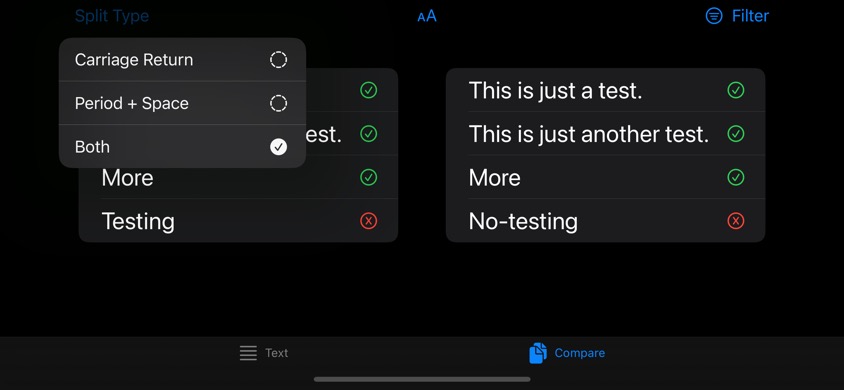

Simple Week for iOS
11/11/2022 Filed in: Simple Week
Finished development on iOS version of Simple Week. I use this app to quickly write down notes throughout the week. This works out great when I don't have time to organize the notes, but just need to get it recorded. I can later transfer the notes to Apple's Notes app which is meant for more permanent note taking. Simple Week works great for temporary notes or data needed on a certain day of the week.
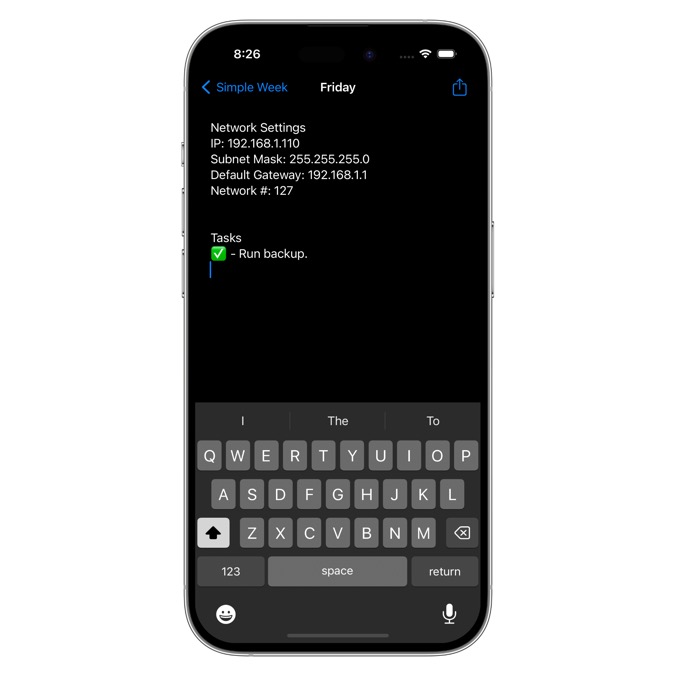

Compare 2 Text for macOS
10/15/2022 Filed in: Compare 2 Text
I commonly needed to compare two .ini files containing configuration information for some software. I need to be able to filter non-matching text data, so I could better synchronize the configuration in the files. 'Compare 2 Text' does all that and a bit more.
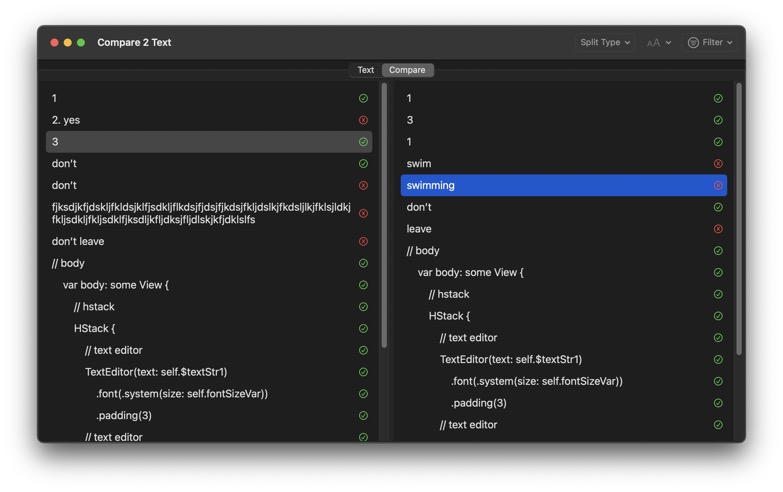

Audio Finder Browser for Windows
10/08/2022 Filed in: Audio Finder Browser
I finished development on my next app, part of the 'Finder-Browser' suite of apps. Audio Finder Browser aims to aid in discovery and playback of audio content in directories. Similar to other apps like Video Finder Browser & Image Finder Browser, Audio Finder Browser has a similar look & feel as well as some of the same functions like Filter and Open Location.
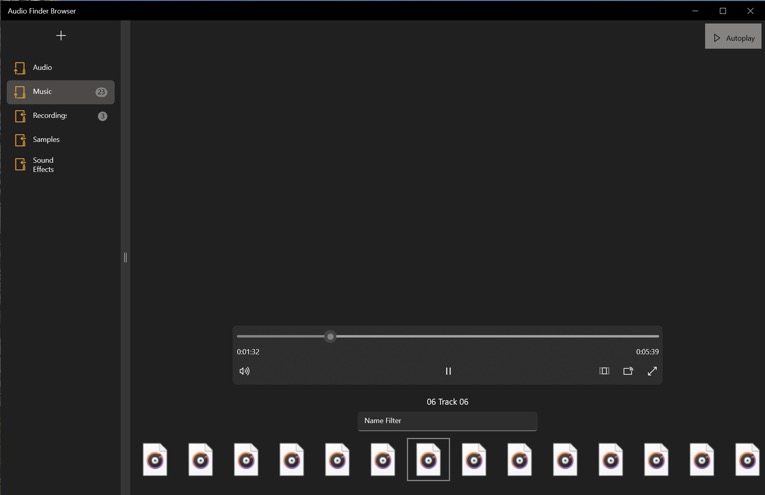

Media Finder Browser for macOS
08/13/2022 Filed in: Media Finder Browser
Media Finder Browser is now complete and is live in the macOS App Store. This app is part of the 'Finder Browser' suite of apps, where is aims to aid in the discovery and viewing of content. I initially set out to develop an app to help me with finding images and videos buried in sub-folders. If you are in need of such an app, please do check them out, thanks!
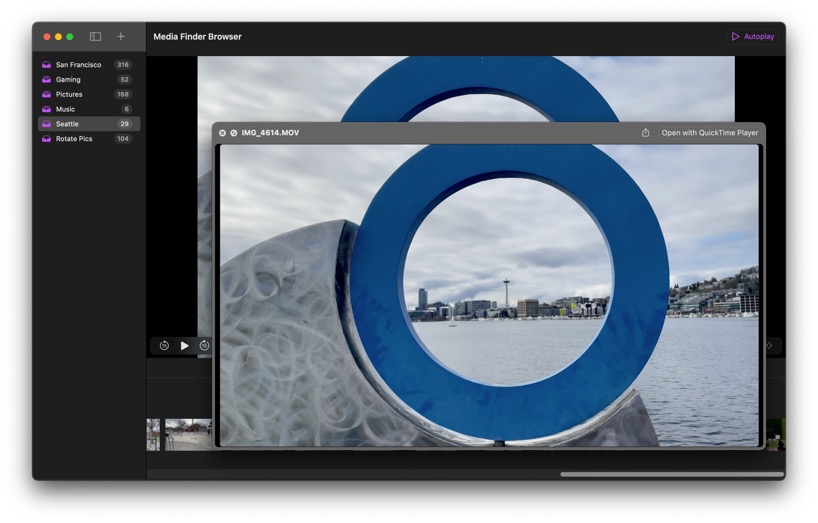

Audio Finder Browser for macOS
08/10/2022 Filed in: Audio Finder Browser
I finished development on my next app, part of the 'Finder-Browser' suite of apps. Audio Finder Browser aims to aid in discovery and playback of audio content in directories. Similar to other apps like Video Finder Browser & Image Finder Browser, Audio Finder Browser has a similar look & feel as well as some of the same functions like Filter and Open Location.
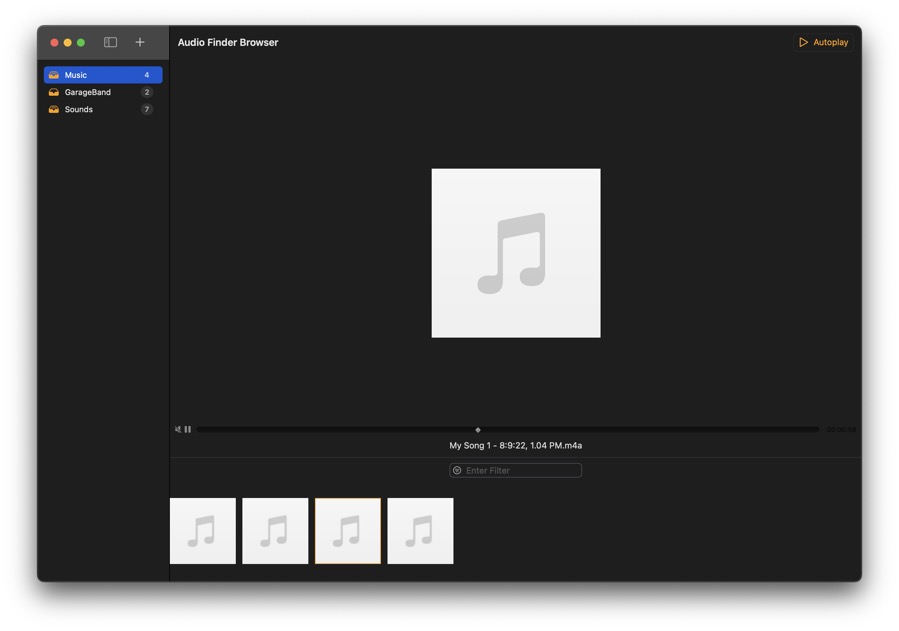

ThatTree Favorites
07/13/2022 Filed in: ThatTree
ThatTree for macOS in Development
07/10/2022 Filed in: ThatTree
Play the Media for Windows update v1.1
06/30/2022 Filed in: Play the Media
Put together some updates for Play the Media for Windows, version 1.1.
• Changed main navigation item appearance.
• Added Soft Load toggle. When turned on, media is loaded into a collection but not displayed. This improves performance. This mode change requires an app restart.
• Added double-click inside the player window toggles fullscreen on/off.
• Enabled background playback capability.
• Added .m4v video support.
• Added support for keyboard shortcuts:
• + - Adds directory
• L - Loads media
• V - Video toggle
• A - Audio toggle
• I - Images toggle
• T - Timer toggle
• P - Autoplay toggle
• S - Shuffle toggle
• M - Mute toggle
• C - Controls toggle
• Shift + Left Arrow - Previous Media Item (focus dependent).
• Shift + Right Arrow - Next Media Item (focus dependent).
• Space Toggles Play/Pause is built-in to media player element, if play/pause button is focused.
• Removed text from icons to allow more button real estate. Text is still shown under tooltip.
• Added History of played Media Items (25 max).
• Added Previous Media Item and Next Media Item toolbar buttons
• Changed main navigation item appearance.
• Added Soft Load toggle. When turned on, media is loaded into a collection but not displayed. This improves performance. This mode change requires an app restart.
• Added double-click inside the player window toggles fullscreen on/off.
• Enabled background playback capability.
• Added .m4v video support.
• Added support for keyboard shortcuts:
• + - Adds directory
• L - Loads media
• V - Video toggle
• A - Audio toggle
• I - Images toggle
• T - Timer toggle
• P - Autoplay toggle
• S - Shuffle toggle
• M - Mute toggle
• C - Controls toggle
• Shift + Left Arrow - Previous Media Item (focus dependent).
• Shift + Right Arrow - Next Media Item (focus dependent).
• Space Toggles Play/Pause is built-in to media player element, if play/pause button is focused.
• Removed text from icons to allow more button real estate. Text is still shown under tooltip.
• Added History of played Media Items (25 max).
• Added Previous Media Item and Next Media Item toolbar buttons
Speak Text in List Focus
06/17/2022 Filed in: List Focus
Added Speech support to List Focus for macOS. This will take a text paragraph and break it into individual text components separated by either period, carriage return, or both. This is a useful app for large text paragraphs where reading is more easily achieved with text broken into a list.
Also developing a Windows version in parallel.

Also developing a Windows version in parallel.

Focus on Sentence from a Paragraph
06/15/2022 Filed in: List Focus
I started development on a new app to highlight a sentence from a paragraph via a List View. I often find myself referencing a paragraph of text and need to maintain a highlight of content; however I need to at times select different parts of the paragraph. This can be cumbersome and time consuming re-highlighting sections of a paragraph.
List Focus will aim to put the paragraph of text into individual List View Items, so the whole Item can be highlight by simply clicking on it in a List View or using a keyboard shortcut to progress up/down through list.


List Focus will aim to put the paragraph of text into individual List View Items, so the whole Item can be highlight by simply clicking on it in a List View or using a keyboard shortcut to progress up/down through list.


ThatView More Changes
11/20/2020 Filed in: ThatView
ThatView Updates - Cancellation System
12/30/2020 Filed in: ThatView
Currently working on programming in a cancellation system for when large directories are being loaded and the user wishes to cancel it and browse to another directory. This will allow ThatView to have better performance and avoid unnecessary processing.
I was able to get it functioning utilizing the
I was able to get it functioning utilizing the
CancellationTokenSource class.ThatView Windows App Progress
01/29/2021 Filed in: ThatView
Managed to get a lot more items completed for ThatView.
- Verify deleting 1 Item (when another Group is also using Item), that it keeps the token in Future Access List.
- Hide preview on back grid tapped.
- On NavItem remove, clear the SubNavs.
- Video preview not working perfectly.
- Need to overhaul IsSelected
- Add Nav hide/show again
- RowView - background preview not releasing on grid click.
- ColumnViewPage.xaml - Getting a consistent crash when scrolling to the bottom of Documents directory (listview). Unhandled Exception, not triggering on any method though.
- Is the Search results using Indexing. - Yes
ThatView Features - Recall & Group Views
03/14/2021 Filed in: ThatView
For ThatView v1.2 added two new features - Recall & Group Views.
Automatically Add Border to Image
04/03/2021 Filed in: AutoBorder
I had an idea for an app to automatically add a border to clipboard images. You see I frequently need to take screenshots and paste them into an e-mail, the problem I encounter is the whitespace in the screenshot blends into the e-mail background - so I have to manually add a border in Outlook, which is very tedious. AutoBorder aims to automate this process by watching for common screenshot keys and mouse positions, then taking the clipboard, adding a border to it, then replacing the clipboard image with the border image. This process actually works pretty slick and is relatively simplistic.
Automatically Format Text
04/08/2021 Filed in: AutoFormat
ThatView App Features
04/23/2021 Filed in: ThatView
Working on some more features for ThatView, including Paste Progress and Loading indicator.
I also added PDF Preview functionality. When clicking a PDF to preview, the PDF view is set to a low opacity to allow for continued visibility of directory and UI. Clicking on 'Hide Views' will show the PDF view in full opacity. The PDF preview supports mouse scroll to change pages and also includes buttons up/down to change pages.
I also added PDF Preview functionality. When clicking a PDF to preview, the PDF view is set to a low opacity to allow for continued visibility of directory and UI. Clicking on 'Hide Views' will show the PDF view in full opacity. The PDF preview supports mouse scroll to change pages and also includes buttons up/down to change pages.
Developing Templated Checklists with ThatList for Windows
05/29/2021 Filed in: ThatList
Printing Templated Checklists with ThatList for Windows
06/03/2021 Filed in: ThatList
For Checklist view, added a Print option. Primarily added this to support printing to PDF.
ThatView File Manager for Windows Feature Change
06/05/2021 Filed in: ThatView
Added a few changes to ThatView for next update v1.4.
- Added tooltip to main navigation items to show Path.
- Changed Recent list to include the Date Opened property.
- Changed sorting to use the Date Opened property.
Auto Resize Clipboard Images with AutoScale for Windows
06/11/2022 Filed in: AutoScale
With ThatList finally complete, I am now starting development on an app I actually really need. AutoScale automatically changes clipboard images scaling to a predefined size. For my day job, I do a lot of screenshots and work with images. I am constantly manually resizing images to fit the space, which can be really repetative.
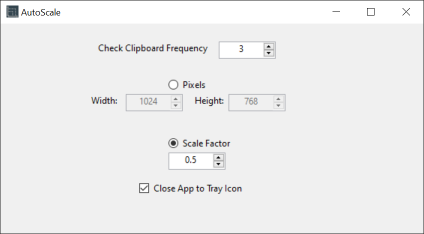

Automatically Save Clipboard Image or Text
07/18/2021 Filed in: Clipboard 2 Folder
Clipboard 2 Folder
I've actually made this form of app before, but it wasn't very polished. Re-designed this app better. Basically Clipboard 2 Folder does exactly what the title describes. It takes the operating system clipboard data and stores the content to a selected folder. This is an excellent way to store a bunch of images, like webpage images or screenshots to a hard drive directory quickly.
ThatView Windows File Manager v1.5 Updates
08/18/2021 Filed in: ThatView
Completed another round of updates for ThatView. This version is v1.5. Below is a list of changes/features.
- Updated UI elements.
- Enabled light mode. ThatView now matches Windows dark/light mode setting.
- Fixed issue when pasting or creating New Folder/Text/Image, the auto-refresh wasn’t pausing.
- Added in the NavItems to the Group navItem right-click list.
- Changed NavView so clicking Group expands/collapses navItem.
- Moved “Open GroupView” to NavItem right-click option.
- Fixed NavItems not selecting when changing Tabs.
- Added welcome screen when first using app.
- Added double-click folder to build-in-self. Note - there are purposely no back/forward controls.
- Increased Dim value for media previews.
- Corrected RowView & ColumnIconView internal drag/drop Collection operation.
- Added image zoom reset when clicking another image.
- Fixed folder item count not updating when navigating to new directory.
- Added new View - Gallery View.
- Fixed performance issue due to new auto-refresh system.
- Added Audio Previews for mp3, wav, aac, and m4a. Note - “Mute Previews” will affect Audio Preview.
- Added Keyboard navigation using Enter key. Tab, Space, and arrow keys also utilized.
- Cleaned up Recent List date/time. Was showing offset.
- Added Recent Folder toggle to Recent list.
ThatView File Manager for Windows Update v1.6.1
10/23/2021 Filed in: ThatView
Working on ThatView file manager update with new features and bug fixes.
- Created new view called TypeView. This view displays file types grouped together by columns.
- Fixed inactive Tab showing pink color.
ThatDesk File Manager for Windows Update v1.2
11/06/2021 Filed in: ThatDesk
Working on ThatDesk file manager update with new features and bug fixes.
- Updated UI elements.
- Added in Indexing option to speed up loading.
- Optimized data loading.
- Fixed tapping List’s Header icon/text to collapse content. The hit area was inconsistent.
- Fixed issue when clicking Refresh when List is collapsed, it was regrowing list height.
- Changed Desk Title to be more prominent.
- Added keyboard Enter key to acknowledge pop-ups.
- Fixed inconsistent Dimming of backdrop image.
- Added auto highlight text for prompts, like Rename & Create Desk.
- Replaced Sort Lists with Reorder. This gives ability to manually sort.
- Changed Recent List to be sorted by Date Accessed.
ThatDesk File Manager for macOS
11/14/2021 Filed in: ThatDesk
Working on ThatDesk file manager for macOS. Still in the early stages of designing and trying to mirror ThatDesk for Windows.
Keep Your Folder Open and Visible
12/18/2021 Filed in: ThatDesk
New File Manager to optimize your workflow and work smarter not harder.
ThatDesk for macOS. Use to keep quick and easy access to chosen directories, files, and websites. With Finder, you are repeatedly opening folder locations again and again. With ThatDesk, set your directories, files, or websites and have fast access to the resources with a single click.
Checkout ThatDesk for macOS, now available via the Mac App Store.
ThatDesk Info
ThatDesk for macOS. Use to keep quick and easy access to chosen directories, files, and websites. With Finder, you are repeatedly opening folder locations again and again. With ThatDesk, set your directories, files, or websites and have fast access to the resources with a single click.
Checkout ThatDesk for macOS, now available via the Mac App Store.
ThatDesk Info
Add Caption to macOS Image
01/08/2022 Filed in: Simple Image Caption
Completed another macOS app called Simple Image Caption. With this app you can assign an image caption, which gets stored to the file's meta-data.
Near Endless Virtual Desktop on macOS
01/29/2022 Filed in: Sidedesk
I built a new productivity app for macOS, called Sidedesk. This app follows along the same lines as its Windows 10 version of Sidedesk. Users can create a Nav menu full of Nav Items that open up into their own custom views and content. From the main view, users can add Elements, which consist of Files, Folders, ListViews, GridViews, Frames, Text, or Images. Clicking and dragging on the main view's background (canvas) will allow you to pan around all the content at once.
Group macOS Files by File Type
02/21/2022 Filed in: Lava File Manager
Completed a macOS file manager app called Lava File Manager. With this app you can manage files using a system of grouped lists. Powerful filter options gives you control over your displayed content, and a Date Range selector keeps results fast and focused to your preferred date modified era.
Add Notes to macOS Desktop Background
02/27/2022 Filed in: Background Notes
Completed another macOS app called Background Notes. Background Notes app allows you to embed text into images as note elements, then set the image as your Desktop Background. As with other Note taking apps, be mindful what content you place as notes. Since background images have the potential to be seen from computer login screens, care should be considered.
- Click the + icon. Type in a text name for navigation item. Click "Add" button.
- Select newly create navigation item. This will load the view.
- Click "Choose Image" button in toolbar. Navigate to an image file and click "Open" button.
- The image will be placed into the view as a "background image".
- Click "Add Text". A new text element will be dropped center in the view. You may need to adjust scroll bars and/or click drag "Zoom" slider to see newly added text element.
- Click + Drag text element around to desired location.
- Double-click text element to open the text-editor sheet. Enter in desired text. Click "Complete" button when done.
- The "Scaling" button can be used to adjust the scaling of text elements. This can be useful for very large dimension images. Default 1.0 scaling will suffice for ~1920x1080 images.
- Keep in mind text elements will be adjusted after change and they may inadvertently move to off view.
- Click the "Set Background" button to combine both the text+image content into an image and set it as Desktop Background.
- To remove a text element, right-click it and choose "Remove".
- To remove a text element that has been lost (e.g. offscreen), right-click the background image, select appropriate note from list and choose "Remove" or "Reset Position" (requires view refresh by clicking blank area of navigation view and then re-clicking navigation item) to bring the text element back to "center".
Image Finder Browser for Windows
03/12/2022 Filed in: Image Finder Browser
I just finished an app i've been working on for awhile, Image Finder Browser. I don't like Windows built-in app for viewing images, it is very convoluted, so decided to put together my own app for viewing images on Windows 10 operating system. I designed it to be simple and to the point - locate and view images in folders.
Image Finder Browser for macOS
03/20/2022 Filed in: Image Finder Browser
I decided to port Image Finder Browser over to macOS. I found the Windows version was quite useful. The macOS version includes a majority of the same features as the Windows version. One thing it is currently missing is keyboard navigation between images. I am planning on including this in the future.
Add Notes to Windows Desktop Background
04/02/2022 Filed in: Background Notes
When I first developed Background Notes concept, it was supposed to be just for Windows. But I was fresh off from making Sidedesk for macOS, so I felt I should continue with using Apple’s Swift programming language to first make Background Notes for macOS, prior to switching to using Windows Universal Windows Platform (UWP) and making Background Notes. After several weeks of working on other projects, I was able to circle back to making Background Notes for Windows. I just finished it today. This was a somewhat fun project to work on - at least once I figured out how to render the image that would be used for the Desktop Background at a higher quality!
Video Finder Browser for macOS Development
04/03/2022 Filed in: Video Finder Browser
I am starting to complete other "Finder Browser" themed apps to support getting easier access to certain file types. Similar to Image Finder Browser, Video Finder Browser aims to make video file locating and viewing easier and faster.
Play the Media for Windows Complete
04/09/2022 Filed in: Play the Media
Finished 'Play the Media' app for Windows. This app can playback video and audio. It also can show images for an adjustable amount of time. This app was requested from a user, where they needed to play random media files. They wanted options for enabling/disabling timer and the ability to choose what directories are included in the randomized content.
Play the Media for macOS Complete
04/24/2022 Filed in: Play the Media
Play the Media for macOS is now available in the macOS App Store. This app is also available for Windows.
Software Updates for macOS Apps
04/30/2022 Filed in: Video Finder Browser | Image Finder Browser
Made some updates to Video Finder Browser and Image Finder Browser.
- Added Selection Border.
- Added Navigation Sidebar pane toggle.
- Added Navigation Sidebar minimum pane width.
Play Multiple Videos at the Same Time with Media Wall Player App for macOS
05/14/2022 Filed in: Media Wall Player
Finished development on a new modern app called Media Wall Player for macOS. The concept behind this app is to visually playback multiple videos at the same time. It has an easy to use navigation view which allows you to quickly switch between directories containing video content. Control the grid layout using two modes, Flexible or Adaptive. Flexible - scales the video player to fit to the window’s size. Adaptive - adjusts the grid columns & rows to shift the videos around into a maintained grid state. There is a Grid Count function which will adjust how many videos are displayed. The more videos displayed the more potential to utilize computer resources like CPU & memory. This may need adjusted for some systems to improve video playback performance. Autoplay can be used to prevent videos from automatically playing when loaded. Controls can be hidden, this may be useful for some users who want to display the app’s videos in a dashboard setting. Standard video playback controls are available like play/pause, full screen, and picture-in-picture. The Shuffle button replaces the videos with another random video from the navigation view’s directory.
Video Finder Browser App for Windows
05/17/2022 Filed in: Video Finder Browser
Finished development on the Windows version of Video Finder Browser. Video Finder Browser is a great way to find videos on your computer. Easily set directories to focus on and quickly explore videos under folders or even under sub-folders. Video Finder Browser includes a fast filter function, so you can find what you need as soon as possible.
Play Multiple Videos at the Same Time with Media Wall Player App for Windows
05/28/2022 Filed in: Media Wall Player
Finished development on the Windows version of Media Wall Player. I thought an app like this would be good to show family videos in a video wall player format. I had already created this app for macOS, now it is available for Windows 10. It largely operates identical to its macOS cousin. The major difference is that the Media Wall Player for Windows doesn't have the 'Flexible' or 'Adaptive' option. Instead it uses a slider to adjust the video player size.
